Barrio Museo
last update: 30 December 2021
Over Christmas 2021 we spent a few day in Seville, in the Hotel Gravina 51 (see our separate report on the hotel). We had no intention to visit the great tourist attractions of the city, but instead we wanted to simply change our surroundings for a few days. To "absorb the atmosphere" as they say.

This webpage starts with a very short review of the barrio, our hotel location, and the local neighbourhood around Calle San Pablo. The major part of this webpage is dedicated to our visit of Santa María Magdalena, a surprisingly interesting parish church that offered us an insight into the past and present of church life in the city.
The barrio Museo
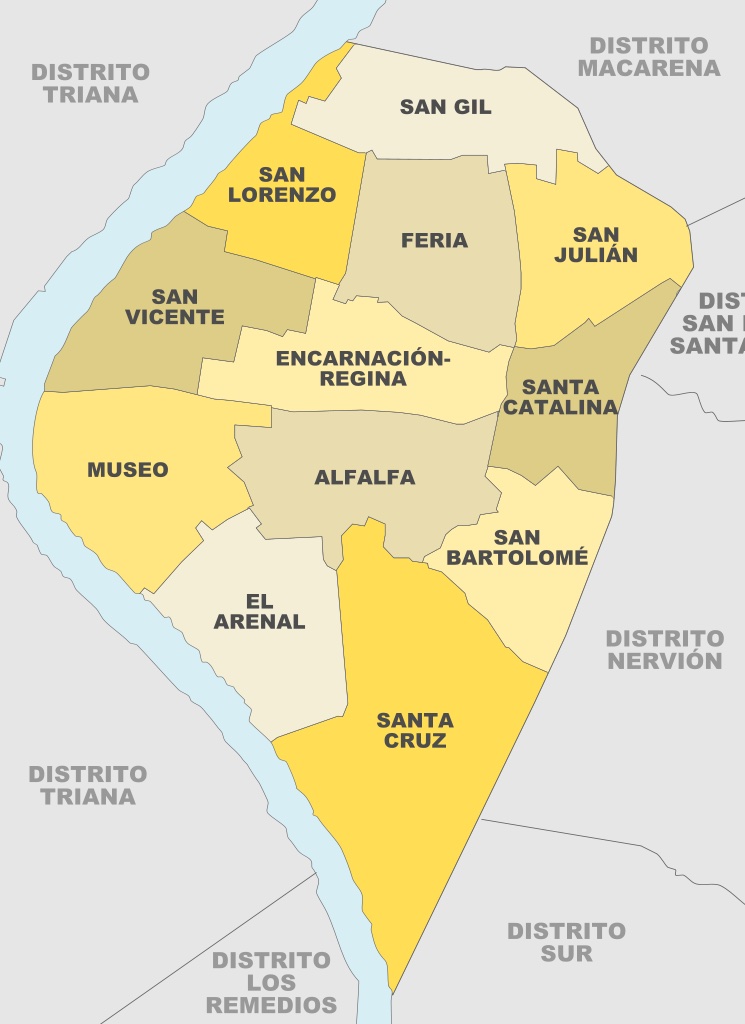
The hotel is in the barrio (neighbourhood) Museo, which belongs to the Casco Antiguo district. The barrio runs along the banks of the Guadalquivir, and to the north touches the barrios of San Vicente and Encarnación-Regina, with the Alfalfa barrio to the east, and to the southeast, the barrio El Arenal.
I guess the name 'Museo' comes from the fact that the Museum of Fine Arts of Seville (El Museo de Bellas Artes de Sevilla), created in 1835, is located in this barrio.
Very little is written about this particular barrio. It has one of the oldest populations in the city, one of the highest level of age-based dependencies, one of the lowest fertility and birth rates, and one of the lowest percentage of foreign residents.
Casco Antiguo is home to around 85% of all offices, workshops, commercial establishments and hotels in the city, despite only concentrating 7.7% of the total population.
The barrio Museo has one of the highest number of commercial establishments, i.e. shops, bars, etc., and in particular is said to be home to more than 40% of Seville's hotels.
Calle Gravina
The Hotel Gravina 51 is located in Calle Gravina which starts at the angle of Puerta de Triana with C/San Pablo, but it appears to be a long narrow road running past the museum and along to C/Alfonso XII.
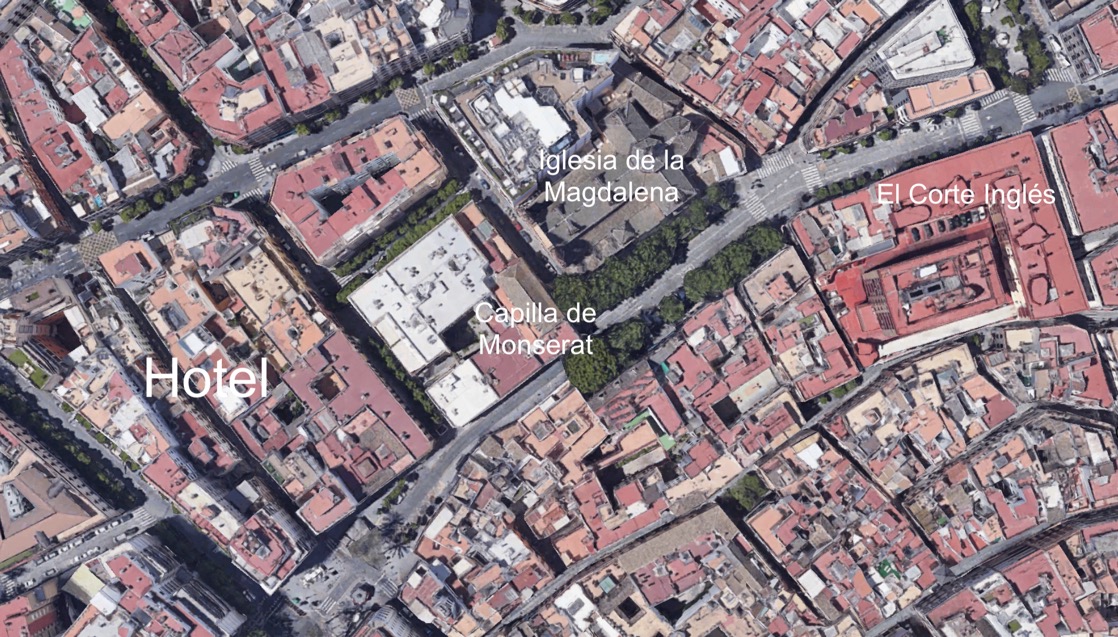
So during our short stay, our 'little world' was defined by our hotel, the Capilla de Monserat on the side street C/Cristo del Calvario, and the Iglesia de la Magdalena and El Corte Inglés, both on C/San Pablo.
This area is residential but with a good selection of tourist hotels. The nice thing was that the vast majority of the people on the street and in the shops were locals. The tourists may sleep in the area, but are usually scrambling around monuments and museums elsewhere in the city.
Calle Gravina was the address of our hotel, but in ancient times it was called 'Cantarranas', appearing with this name in a municipal document from 1408. The origin of this name is uncertain, although they say very indicative of the place (not sure but it could mean 'singing frogs'). The historian González de León (1790-1854) attributed the name to a swampy space through which the street ran. And a few centuries before, the Spanish poet Juan de Mal Lara (1524-1571) suggested that the name "cantarranas" was "for some pipes and drains through which the city is cleaned". The street name was kept until the middle of the 19th century, when it was replaced by the current one, in memory of the Captain General of the Spanish Navy Federico Carlos Gravina y Napoli (1756-1806), who died after the battle of Trafalgar. In a plan from 1870, it appears that the name of C/Cantarranas was still used through to C/San Pedro Mártir and then became C/Gravina. In 1935 an agreement was made to add the word Admiral to the name, but it was soon revoked.
The atmosphere of C/Gravina was conditioned, to a great extent, by the fact that it was one of the largest drains in the city, due to its proximity to the river and the city wall. Every time it rained, lagoons would form and the air would be infected with bad smells. During three centuries, from the 16th to the 19th, there were constant demands in the neighbourhood to clean the drains and pave the street. In 1629 the inhabitants had already noted "cuando llueve no puede pasar ni el Santísimo ni las mujeres a oír misa" (when it rains neither the Blessed Sacrament nor the women can pass to hear mass).
I would add that the whole area, including our hotel, is now perfectly civilised, and offers all the amenities that you would expect in the 21st century.
Calle San Pablo
On C/San Pablo we have a microcosm of Spanish everyday life. In addition to the church, it is home to a number of bars and food shops, such as 'flores' a gourmet shop and terrace, specialising in hams and wines. This up-market trend is supported by Lucas Fox, selling multi-million € real estate. On the other hand, the street is also home to a MAS a corner supermarket, and to toy and trinket shops, mid-market clothes shops, a 'Farmacia' and separate 'Drogueria', a variety of coffee shops and terraces, the usual sushi shop, and numerous panaderías, cafeterías, pastelerías (and the inevitable but popular Burger King).
I guess the hot spot of the street is El Corte Inglés, of which I think there are six in Seville. Set over two floors its focus is on clothes and home goods, etc.
Naturally there are also the usual closed shop fronts up for sale or rent, and even a larger 'palace-like' building all locked up and nowhere to go.
The whole area was clean, safe, and surprisingly well equipped with city bicycles, and rental options for e-scooters and Vespa-like scooters.
Iglesia de la Magdalena

The local parish church is Santa María Magdalena, a Baroque style Catholic Church, which was once the church of the Dominican Convento de San Pablo el Real. The reality is that the original parish church and most of the original convent no longer exists. Reading through the history of the two, i.e. the old parish church called Santa María Magdalena and the present-day Santa María Magdalena now located in the old convent church, there is plenty of scope for confusion.
Before we look at the history of Santa María Magdalena we need to dispel that confusion. Below we can see part of the barrio Museo, and we can see the present location of the church (in red) and below that it's floor plan. The original parish church was located in what is today Plaza de la Magdalena. Historically it was a smaller square in front of the church, and was actually just called Plaza de la Magdalena. The old parish church was demolished in 1811 during a period when the city was occupied by French military forces. The parish church was moved to the church in the Convento de San Pablo el Real, a local convent that was also be occupied by French forces. Plaza de la Magdalena was later redeveloped and expanded between 1840 and 1850, and the central fountain was installed in 1844. In 1841 the plaza changed its name to Plaza de la Libertad, then in 1869 Plaza del Pacifico, then in 1928 Plaza de Cristo del Calvario, then in 1931 again Plaza del Pacifico. In 1936 it became Plaza del General Franco, before (finally) again becoming Plaza de la Magdalena in 1980.
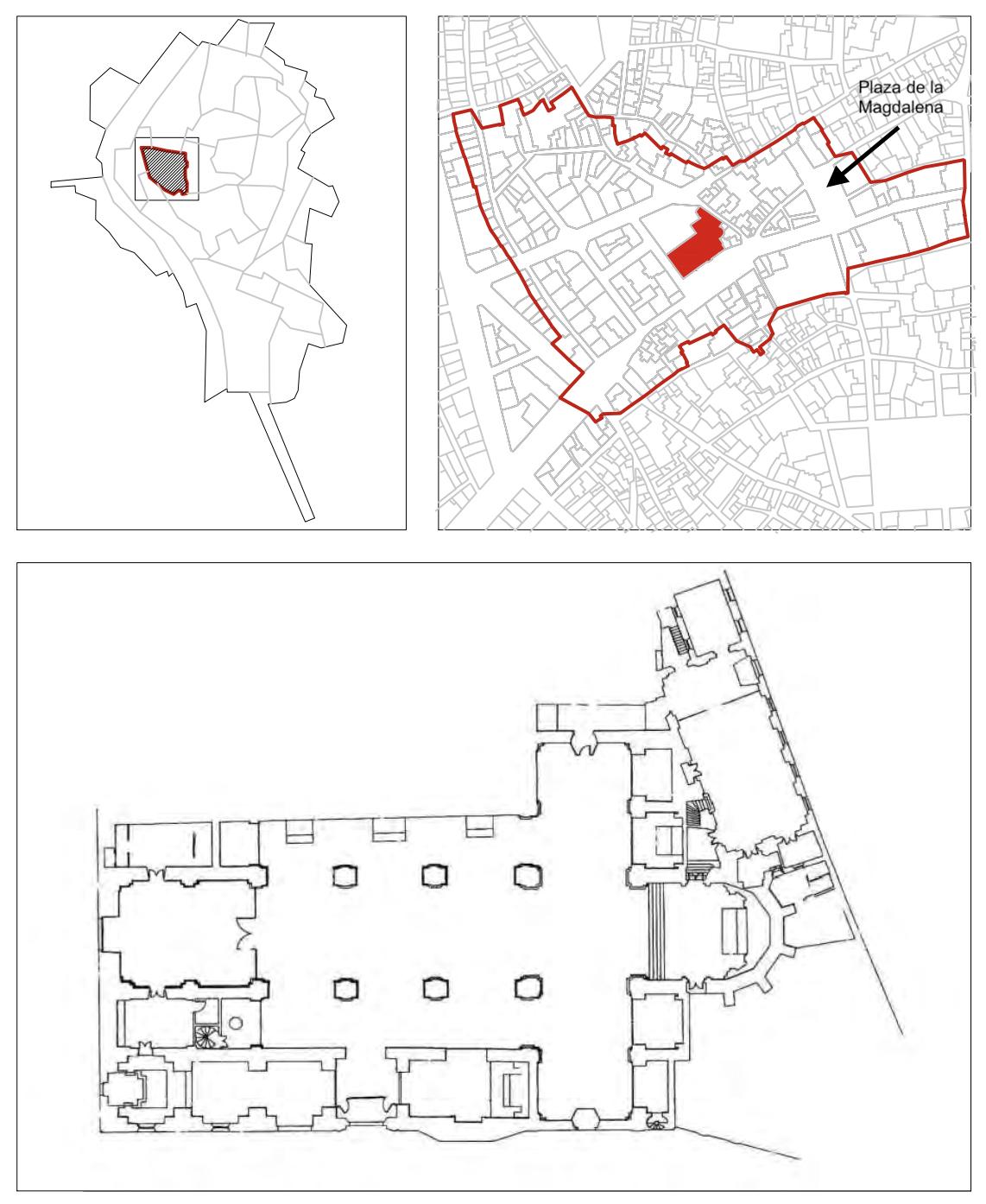
Below on the left, we have the layout of the old Convento de San Pablo el Real in 1860. We can see that the convent church had already become Santa María Magdalena, and the other old buildings of the convent had become civil buildings. The more recent street plan on the right shows how the whole convent area has been redeveloped (the church buildings are still in grey).

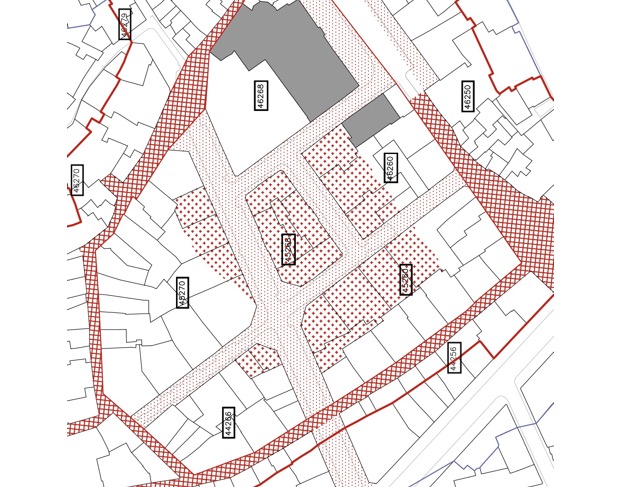
Today Santa María Magdalena is home to five confraternities, namely, the Hermandad Sacramental de la Magdalena (Sacramental Brotherhood of La Magdalena), the Hermandad de Nuestra Señora del Amparo (Brotherhood of Nuestra Señora del Amparo), the Hermandad de la Quinta Angustia (Brotherhood of Quinta Angustia), the Hermandad de Montserrat (Brotherhood of Montserrat) and the Hermandad del Calvario (Brotherhood of Calvario).
Don Remondo (d. 1288), the first bishop of Seville after its reconquest by Fernando III (1199-1252), drew up the city into twenty-four parishes. Wanting to represent a general vision of the Church he dedicated different parish churches to the Saviour, to his Mother, to the archangel Saint Michael, to Saint John the Baptist, to the Holy Apostles, and to a variety of virgins and saints, including Saint Mary Magdalene.
According to the historian Ortiz de Zuñiga (1636-1680), already on May 3, 1255, there is evidence of a letter in which Alfonso X (1221-1284) confirmed a separate donation made by his father, Fernando III. The donation was for some land for the Order of Preachers (Orden de Predicadores also known as the Dominican Order). The parish of La Magdalena, in which the old Almohad city wall ran along the present-day Gravina Street, was adjacent to the river where there were still orchards and semi-empty spaces ideal for convent foundations.
Santo Domingo de Guzmán (1170-1221), founder of the Dominican Order, fought tireless against the heresies of his time, and he looked to restore the unity of the Christian faith threatened by heretics. These heresies gave rise to the creation of the primitive Inquisition in France in the year 1184. Fifty years later, in 1231-1233, Pope Gregory IX (ca. 1145-1172) created through the bull Excommunicamus, the Pontifical Inquisition, that was established in several European Christian kingdoms during the Middle Ages.
So one part of the story started with a donation made in 1255 by Alfonso X, for the building of a Convento de San Pablo el Real (Saint Peter). The site itself would appear to have already been occupied by friars of Santo Domingo (so already the Dominican Order). This convent of San Pablo el Real de Sevilla was the second of the Order of Preachers to be erected in Andalusia. The first was the convent San Pablo de Córdoba, founded in 1236 and demolished in 1848, although the church itself still exists.
Records indicate that a first primitive convent church was burned and rebuilt in the time of King Pedro I of Castile (1334-1369), probably between 1350-1366. There is mention of a gift of 500 doblas to the convent because when Pedro I was ill, his mother entrusted him to the convent and to the resident Virgin de las Fiebres (Virgin of Fevers).
Other sources mention a strong earthquake in 1355, and the fact that a church (convent or parish) was rebuilt in the popular Gothic-Mudéjar style.
Different reports mention, as was the tradition at the time, that one or both of the churches would have been built over an old mosque.
One report stressed the importance of the 14th century convent church, mentioning the building of three free-standing Mudejar-style chapels for the Medina, Rosales and Gómez de Espinosa families. These three chapels now make up the separate chapel of La Quinta Angustia.
During the stay of Isabella I (1451-1504) in Seville between 1477 and 1478, the Sevillian Dominican Alonso de Ojeda, Prior of the San Pablo convent, convinced the queen of the existence of Judaizing practices among Andalusian converts. A report sent, at the request of the sovereigns, by Cardinal Mendoza (1428-1495), who was Administrador apostólico de Seville, and by the Dominican Fray Tomás de Torquemada (1420-1498), corroborated these suspicions.
In January 1481 the Spanish Court of the Inquisition settled in the convent of San Pablo, with the Prior Fray Alonso de Ojeda. The Spanish Inquisition set out to maintain the purity of the faith and to prevent Spaniards from falling into heresy. It pursued a series of tests that showed whether someone was Judaizing, Moorish, Lutheran, enlightened or manifesting any deviation from the Catholic faith. The connection of the Order of Santo Domingo with the Defence of Truth was not unusual, given that appointments to inquisitorial positions and functions were accepted by the Dominicans without any opposition.
In total there were five Inquisitors General belonging to the Order of Santo Domingo - Tomás de Torquemada, first inquisitor general, Diego de Deza (1444-1523) who was archbishop of Seville from 1504, García de Loaysa (1478-1546) who was archbishop of Seville from 1539, Antonio de Sotomayor (1557-1648) confessor of King Felipe III and his children, and Juan Tomás de Rocaberti (1627-1699) the archbishop of Valencia from 1676.
The Tribunal of the Holy Office began its activities in the convent of San Pablo, and the first inquisitorial sentence was pasted in 1481, with the convent being the first prison.
It has been written that the Dominican Fray Alonso de Ojeda was "jealous of the faith of Jesus Christ" and was the "one who most sought this Inquisition in Seville". But it also has been written that "Castile owed its spiritual stillness" and Seville "its cleanliness in the Christian and Catholic religion" to Fray Alonso de Ojeda.
There are also ample records indicating that the convent church suffered considerable damage during the earthquake on the morning of Good Friday, April 5 of 1504. Accompanied by winds and storms, the earthquake caused the collapse of the towers and roof of the buildings, and "numerous cracks were opened in the very strong cathedral building".
There are reports that the convent church roof collapsed, and Wikipedia notes that the Catholic Monarchs gave the convent alms for the repair of their church roof. It would appear that the senior knights of Seville did much to restore the roofs, and they had their arms painted on the roof joists for all to see.
In 1552 Pope Julius III (1487-1555) named the convent a university. Many Dominican friars stayed in this convent and then later went to evangelise America and the Philippines. Some of these missions to the Indies were organised by the Sevillian Bartolomé de las Casas (1484-1566).
Over time the convent grew to be the largest in Andalusia with 200 friars, but in 1649 85 of them died due to the plague epidemic that devastated the city. The convent recovered and in 1757 there were again 190 friars.
On November 1, 1755, the novena to the Virgen del Amparo was celebrated in the parish church of Santa María Magdalena. This was a series of nine days of prayer to Nuestra Señora del Amparo, a 16th century work attributed to Roque de Balduque (d. 1561) who was famed for his images of the Virgin Mary. Around ten o'clock in the morning, the aftershocks of the Lisbon earthquake reached Seville, damaging more than 5,000 houses and several churches and convents, including Seville's cathedral. However, neither the parish church nor the parishioners of Santa María Magdalena suffered any damage, which was interpreted as protection of the Patronage of the Virgin (ampero can mean protection in Spanish).

It is said that the Archbishop of Seville, Don Fernando de Valdés (1483-1568), founded a pious institution called "Amparo de María Santísima y San José", the purpose was to welcome foundlings, whose numbers were considerable at that time. Around then the Flemish sculptor Roque Balduque was based in Seville, to whom the authorship of the Sacred Image has been attributed. Patron of the aforementioned institution Pope Alexander VII (1599-1667) granted the Church of Spain the feast entitled "Patronage of Our Lady", establishing it on the second Sunday in November. Later, this feast would be extended to all Christendom by Benedict XIII (1649-1730). A Hermandad (Brotherhood) was approved to worship this Sacred Image in 1736, and despite having its ups and downs, it is still active today. For more information check out Hermandad del Amparo.
The arms painted on the roof joists were still visible when the convent church again was severely damaged by another earthquake of October 9, 1680, that had its epicentre in Malaga. Although "there was no need to mourn the loss of any human life, there were moments of great anguish", and the church needed "considerable repair". In fact one of the main walls had to be supported with “two arches or flying buttresses in the middle of the main chapel on the outside, one on one side, and the other on the other to support the wall". In addition, "some time and a lot of money were spent" in lightening the load on the roof and in rendering it watertight, so that the church remaining open for worship. Nevertheless, it was found that "all the rest of the Church needed repair", and “that many of the beams were rotten".
Discussion started on how the repair work could be done "in such a way that the Church was styled in the modern style", i.e. vaults made of brick, new round arches set on the existing pillars, larger windows, and a larger, more comfortable choral space. In addition, the three chapels belonging to the brotherhoods (cofradías) of Nuestra Señora de la Antigua y Siete Dolores, Dulce Nombre de Jesús and Nuestra Señora de Montserrat, were so small that they had to constantly leave the cloister to pray. Finally the Blessed Sacrament had to be transferred to a temporary enclosure on July 21, 1691, the eve of the feast of Santa María Magdalena. A chronicler noted that this was a day “of great tenderness and tears, both from the Religious, as well as from the laity who were present at the translation, saying all of them: Who will see the Blessed Sacrament again, and the Blessed Virgin of the Rosary in your House, and temple?".
In the course of the works on the church, some of the stone pillars were freed up, and to make their appearance more Baroque “some ornaments were cut, pulling them out of the stone itself”. At the same time, a brick vault was formed, but leaving in place the woodwork and an old pointed arch. One new arch was completed, but when the erection of the second was about to begin, on December 1, 1691, an unexpected event occurred ('unexpected' might be an understatement). At sunset and after finishing their working day, everyone had just left the church when "the pillar next to the cross fell down" with a roar that frightened not only the friars, but the entire neighbourhood. Not yet recovered from this shock, just after eight o'clock at night a second pillar fell, again causing great fear, and at eleven o'clock at night a third collapsed, along "with all the wood, and ceilings of the middle nave".
There is a separate report that indicated that whilst the convent church collapsed in 1691, the separate chapel of La Quinta Angustia survived.
Wikipedia appears to attribute the problems between 1691 and 1692 to the overflowing of the Guadalquivir. However conclusions at the time, and those more 'savant' in 1829, were that the new brick vault "pushed the pillars on which the old arches rested, and whose heart was made of rubble, earth and little lime", and "the old buttresses not being able to bear so much weight and thrust" eventually collapsed. Opinions of the day and much later, all coincide in pointing out the internal weakness of the church's pillars as the fundamental cause of its ruin, as they were unable to withstand the thrusts and overload of the new arches and vaults that sought to transform the internal appearance of the ancient church.
In the days immediately after the ruin of the church, everything had to be cleared away. The friars who made up the community began by removing the waste and rubble in a large number of baskets. Many neighbours, knights, ecclesiastics and even children "helped not only to remove the land, but to dig it with picks, and hoes, and to carry the rocks". We are told that there was a day when up to five hundred people came together to work, but women carrying loaded baskets "was not allowed by the decency". In just five and a half days they were able to remove all the rubble. But what had remained standing of the temple "was tormented with ruin, and that nothing could serve", so the rest of the church ended up being demolished except for a few important walls.
The new plans were "found to be extremely good, and made according to the art", and they found that they could reuse the remaining walls "so that they would gain strength and security". This was a great saving in time and money, given that the cost was calculated at more than 30,000 ducats. The work began with bringing from the quarries the red and black jasper that would be the capitals and bases of the new Corinthian pilasters.
The ceremony of the laying of the first stone was held on Thursday, July 24, 1692, the eve of the feast of Saint James (Santiago Apóstol). We are told that from "the last months of the year 1692" work was ongoing without stopping. In 1694 the upper pediment of the portal was built and in 1697 the rose window in the upper choir was installed. It would appear that Fr. Joan de la Barrera, son of the convent, directed the work for 17 years. Finally the money ran out and they had to "close" the work in the middle of 1707. The last order was on November 16, 1705, when the attorney general of the convent, Fr. Francisco de Perea (1666-1733), contracted with the master stonemason Francisco de Ganzarain, an order for a total of seventy-six pieces of cut stone, of different measures and sizes, extracted "from the quarry that they call the Asesinos de Jerez de la Frontera", to the price of seventeen reales per linear rod (Spanish canna).
We also have to remember that with the occasional torrential rain the Guadalquivir would overflow. Although the repairs that had been made at the gates of the city prevented the river from entering, the fact that the drains were closed caused the streets to clog up and flood the basements and lower rooms of almost all the houses. The convent of San Pablo was not spared, because the waters reached its very doors and "preventing going out into the street, if it was not with a lot of work, and hardship". Inside the monastery the garden and the refectory and the kitchen also flooding.
The church was forced to open in 1708, without being completely finished (e.g. still lacking flooring).
That first stone laid in 1692 was according to the drawings of the most famous of the architects in Seville at that time, Leonardo de Figueroa (ca. 1650-1730). The church was finally consecrated on October 22, 1724. Figueroa was obliged to adapt his design to some practical constraints. Firstly the original stone apse of the main chapel determined the width of the new central nave. In addition the Mudejar chapels were made into the current chapel of the Hermandad de la Quinta Angustia and joined to the new building.
However, experts praised Figueroa for the way he created a Baroque church out of a medieval church, by adding an exuberance of plasterwork and the use of brick and polychrome tile.
During the Napoleonic invasion of Spain, the French occupied Seville on the 31 January 1810, but were forced to retreat on 27 August 1812. Wikipedia mentions that the French troops looted the convent and occupied it as a barracks. During the occupation the city was transformed by widening streets and opening new squares, usually at the expense of convents and churches. In fact in 1811 the old parish church was demolished creating the current Plaza de la Magdalena, and the convent church was converted into the parish church of Santa María Magdalena. When the French retreated, the Dominicans returned to the convent and began repairing the damage, and in 1817 the parish moved back to a partially rebuilt parish church. After the confiscation in 1835 of the Dominican convent by Mendizábal (1790-1853) the reconstruction of the old parish church was abandoned, and in 1842 the parish church of Santa María Magdalena was permanently moved to the convent church. The rest of the convent was converted to civil offices. Some parts were demolished in 1889, and the remaining part destroyed by fire in 1906. So today only the church, the sacristy and the Chapel of Montserrat remain from the old convent.
Now for the visit…
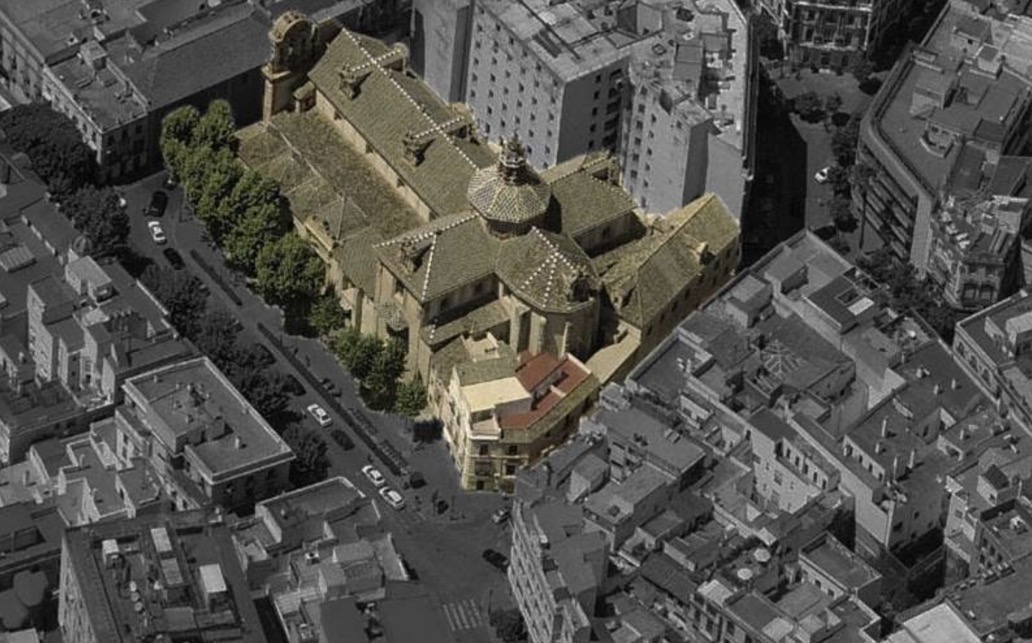
In the references there are a number of extensive photographic collections documenting every nook and cranny, so I'm only going to rapidly look at the things that caught my attention.
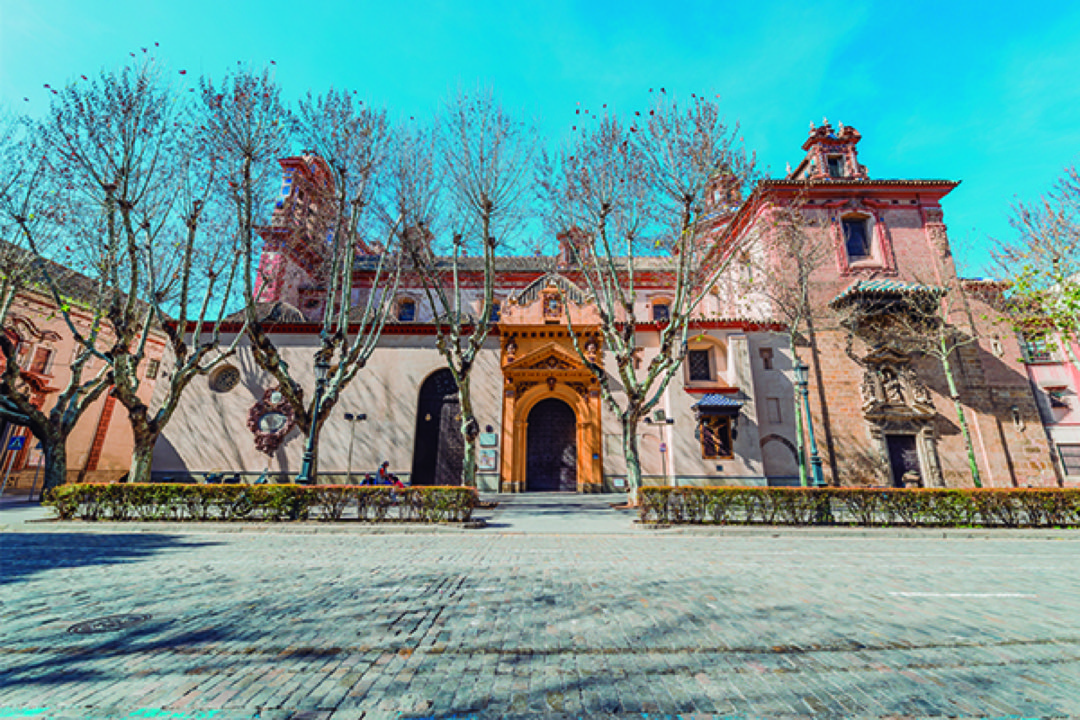
Above we can see the side façade of the Iglesia de la Magdalena on C/San Pablo. The entrance is the central sandstone portal, and the entrance slightly to the left accesses the separate chapel of La Quinta Angustia. I've included this photograph simply because it is so unique. No traffic, no cars parked in front, no pedestrians, and it's winter so no tree canopies blocking the view - truly unique.
It's difficult to capture that moment when we entered the church. It was just after mass on Sunday 26th December 2021, and the church was still full, the lights were on, the sense of occasion was intense. The photograph below does not capture the true feeling…
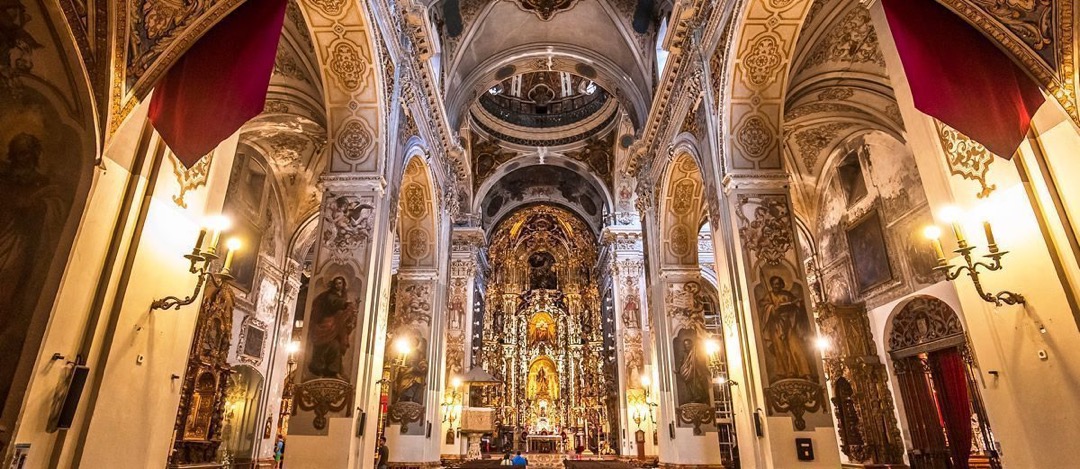
What a surprise! Totally out of context with the rather severe and unexpressive exterior.
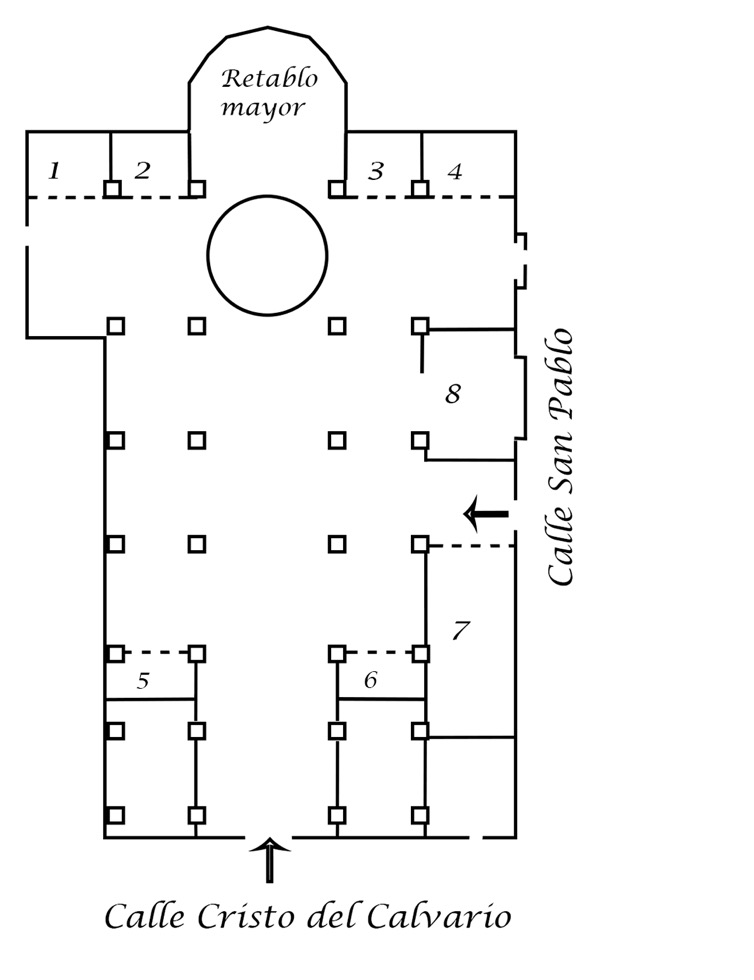
The interior design is simple, consisting of a central nave and two side-aisles. The transept is quite compact, and the cross is topped with a dome. The plan follows the line of many medieval buildings, with a deep polygonal apse and four small chapels open to the transept. The roof is a barrel vault with lunettes and transverse arches in the nave and transept, and the two side-aisles have groin vaults. In the centre of the transept there is a large dome with an octagonal drum and topped with a lantern, made up of attached Telamons that descend in thick scrolls. The drum and lantern are the most baroque part of the building, and outside it is even topped by a wrought iron royal crown.
There are eight chapels:-
1 - Chapel of the Virgen de la Antigua
2 - Chapel of the Virgen del Amparo
3 - Chapel of Christ of Calvary
4 - Chapel of San Antonio
5 - Chapel of the Virgin of the Rosary
6 - Baptismal Chapel
7 - Chapel of the Fifth Anguish
8 - Sacramental Chapel.
The choir actually sits over the foot of the central nave, covering the entrance from C/Cristo del Calvario. The interior is decorated with wall paintings, plasterwork and gilt wood moldings from the end of the 17th century. The sculptures of the niches of the presbytery and transept, are from Pedro Roldán's (1624-1699) workshop. The vault of the presbytery is by Lucas de Valdés (1661-1724), and the transept, dome, the side naves and the first pillars were from his workshop. The last pillars were painted by Clemente Torres (1662-1730).
All the construction is in brick, and part of the exterior is left visible as is the cupola and belfry. The work is decorated with applications of reliefs in fired clay.
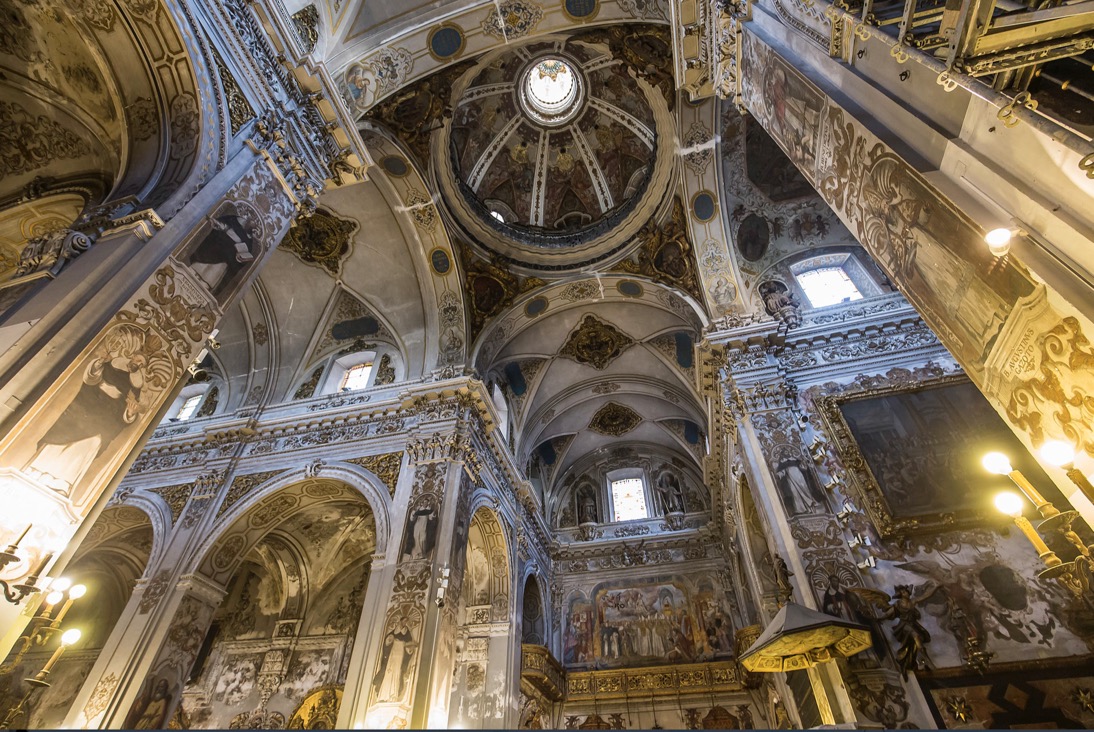
Looking up at the central dome with the thematic paintings to the Glory of the Virgin, one is struck by the profusion of decoration on every surface. Wherever you look you see images of saints and angels.
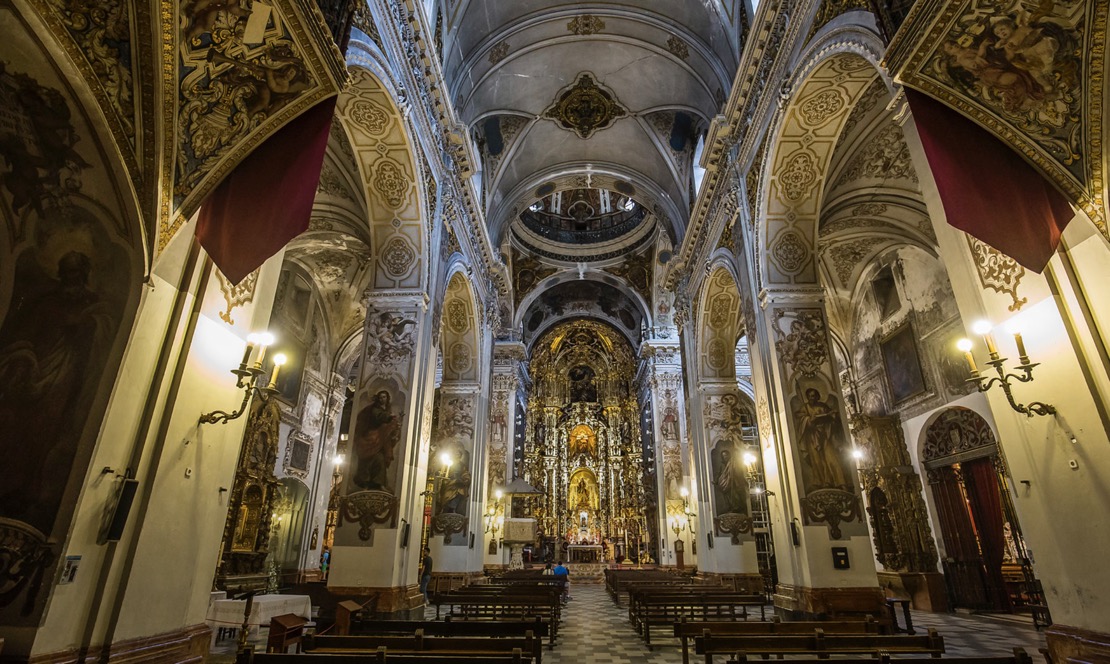
Entering we turned to the back of the church, near the main entrance, so as to take-in the entire central nave. We approached slowly the transept, trying to understand the profusion of decoration in the chancel (with the sanctuary, apse and altar).
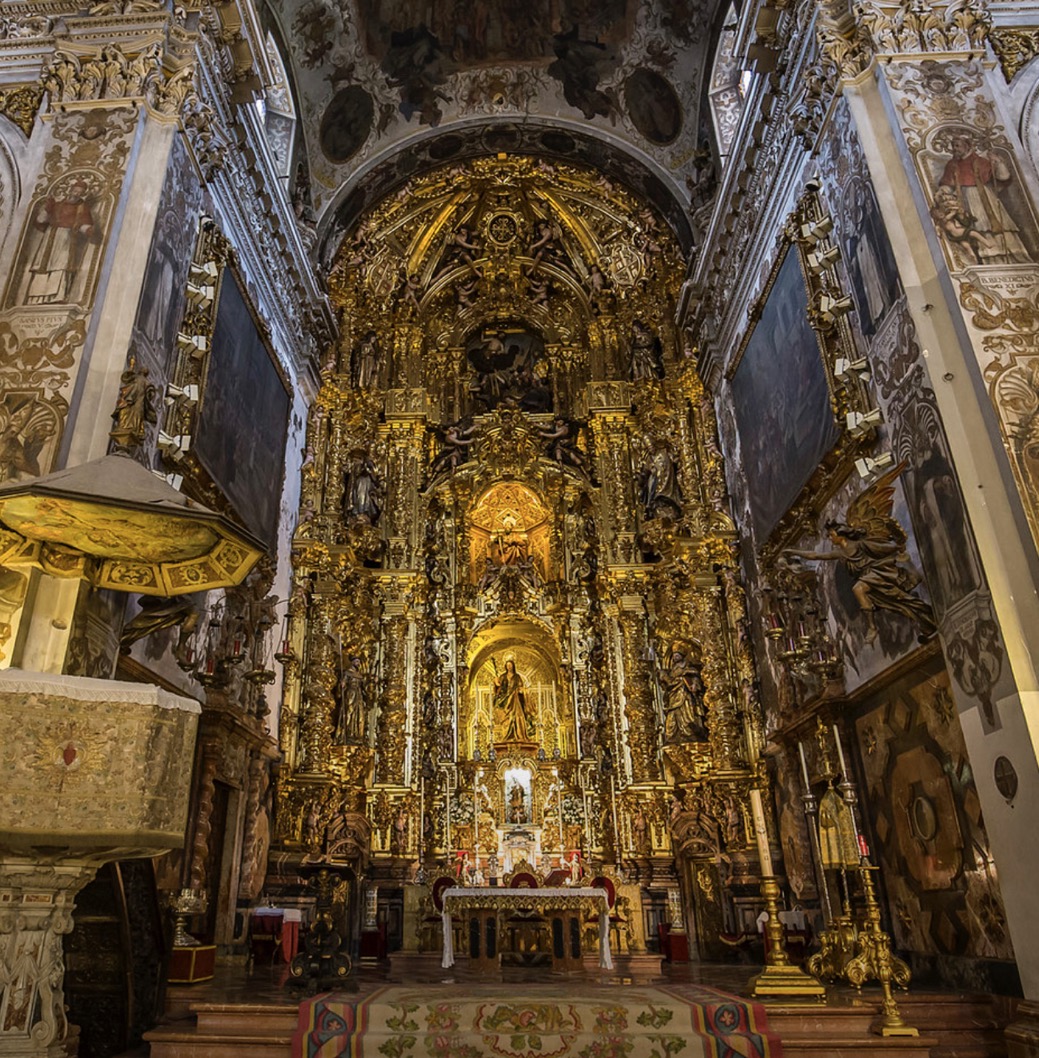
The altar itself dates from between 1709 and 1724, and has been attributed to Leonardo de Figueroa and Pedro Duque Cornejo (1677-1757). It is an altarpiece of great proportions, covering 160 square metres and is 18 metres high.
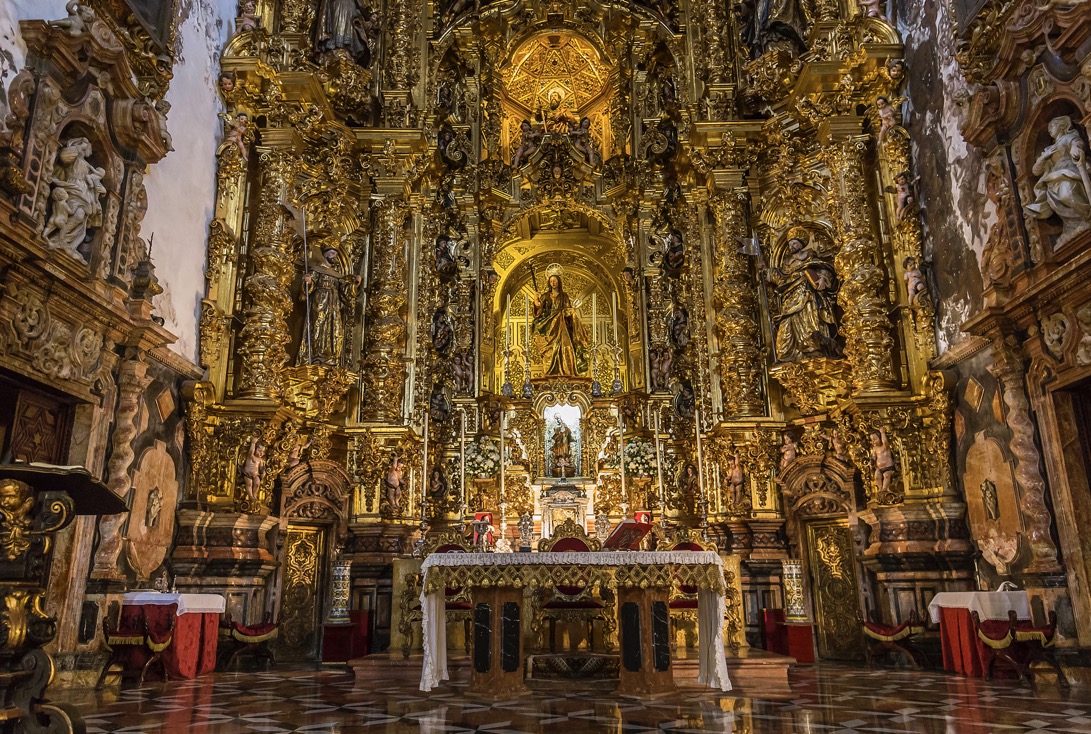
The altarpiece is dedicated to Saint Paul, but the central niche currently contains the sculpture of Santa María Magdalena made in 1704 by Felipe Malo de Molina. It was transferred from the old parish church in the mid-19th century.

Having zoomed in on María Magdalena, it's only natural to ask who was she? Why is she now a venerated saint?
According to ¿Quién fue María Magdalena? we must first turn to the Bible. Luke 8:2 tells us that among the women who followed Jesus and assisted him was Mary Magdalene, that is, a woman named Mary, who was a native of Migdal Nunayah, in Greek Tariquea, a small town next to the Sea of Galilee, 5.5 km north of Tiberias.
From her Jesus had cast out seven demons (Luke 8:2 and Mark 16:9), which is the same as saying “all demons”. The expression can be understood as a diabolical possession, but also as a disease of the body or spirit.
Surprise, surprise, demons have their own classification, in fact several different classifications. It's not even clear if the same classification system was used in different countries, but for simplicity we shall go with the "seven deadly sins", namely Pride (Lucifer), Envy (Beelzebub), wrath (Sathanas), sloth (Abaddon), greed (Mammon), gluttony (Belphegor) and lust (Asmodeus).
The synoptic gospels mention her as the first of a group of women who contemplated the crucifixion of Jesus from afar, and who remained seated in front of the tomb while they buried Jesus. They point out that in the early morning of the day after Saturday, Mary Magdalene and other women returned to the tomb to anoint the body with the aromas they had bought. Then an angel informed them that Jesus had risen and charged them to go and communicate it to the disciples.
Saint John presents the same information, with small variations. Mary Magdalene is next to the Virgin Mary at the foot of the cross. After Saturday, when it was still night, she approaches the tomb, she sees the stone removed and tells Peter, thinking that someone had stolen the body of Jesus. Back at the tomb, she is crying when she meets the risen Jesus, who entrusts her to announce to the disciples his return to the Father. For this reason, the tradition of the Church has called it in the East "isapóstolos" (like an apostle) and in the West "apostola apostolorum" (apostle of apostles). We must remember that apostle comes from the Greek to mean "person sent".
In the East there is a tradition that she was buried in Ephesus and that her relics were taken to Constantinople in the 9th century.
Mary Magdalene has often been confused with other women in the Gospels. From the 6th and 7th centuries, the Latin Church tended to identify Mary Magdalene with the sinful woman who, in Galilee, at the home of Simon the Pharisee, anointed the feet of Jesus with her tears. Previously Mary had already been 'identified' as the sister of Lazarus of Bethany who anointed the head of Jesus with perfume. Matthew and Mark do not give the name of Mary, but say that she was a woman and that the anointing took place in the house of Simon the Leper.
As a consequence, due in large part to Saint Gregory the Great, the idea spread in the West that the three women were the same person. However, the evangelical data do not suggest that Mary Magdalene should be identified with Mary, the one who anoints Jesus in Bethany. Nor do the data allow us to deduce that she is the same as the sinner who anointed Jesus. In any case we should not forget that Jesus praised the love of the sinful woman "Her many sins are forgiven, because she has loved so much", so a sinful past is not a disgrace.
Because of her prominent role in the gospels she received special attention in some marginal groups of the early Church, an attention with no historical foundation. Fortunately, in the Second Vatican Council she was seen more as a disciple than as a sinner. In fact, she is the patron of Pharmacists, Drug Manufacturers, Glove Manufacturers, Hairdressers, Stylists, Perfumers, Reformed Prostitutes and Women in general, among other groups.
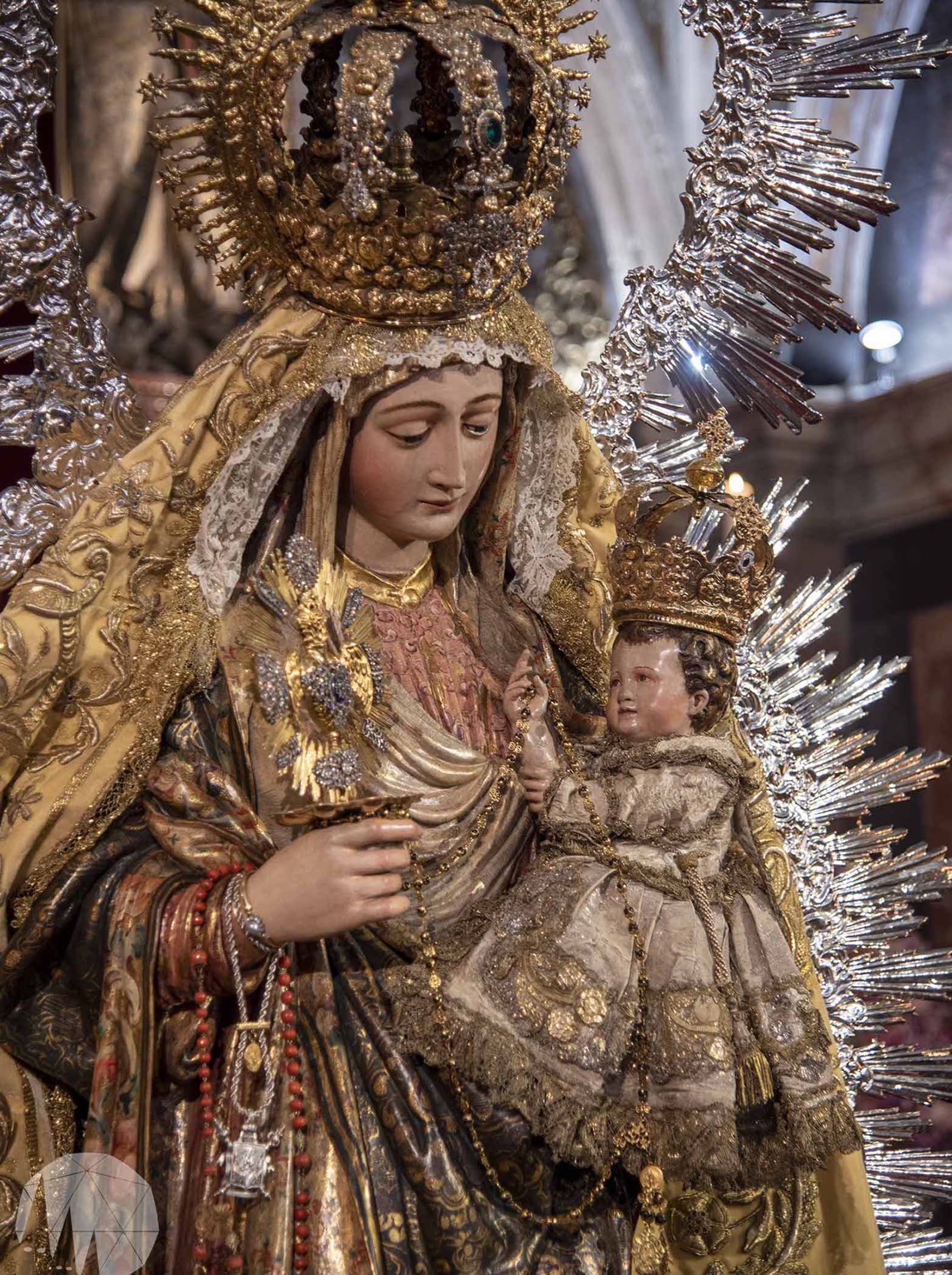
Tradition has it that the Hermandad de Nuestra Señora del Amparo can trace its ancestry back to the Archbishop of Seville, Don Fernando de Valdés y Salas (1483-1568). He founded a pious institution called "Amparo de María Santísima y San José", whose purpose was to welcome foundlings. At the same time the Flemish sculptor Roque Balduque (d. 1561) was based in Seville, to whom the authorship of the Sacred Image has been attributed. When the virginal simulacrum was found in the Parish of Santa María Magdalena in 1735, a Brotherhood was formed to worship it. The Brotherhood almost disappeared during the great epidemic of 1800. After the demolition of the old parish church, on June 16, 1810, the Sacred Image was taken to the ex-convent of San Pablo, and on May 19, 1815 was placed in the Chapel of the Hermandad de Antigua, Siete Dolores y Compassion (current Chapel of the Brotherhood of Montserrat). The Sacred Image remained there, presiding over the High Altar, until January 22, 1848, when the Parish was definitively established in the old Dominican church. The Sacred Image was then moved to its current location. The 19th century was a difficult period, but through the 20th century the Brotherhood has attracted many new faithful members.
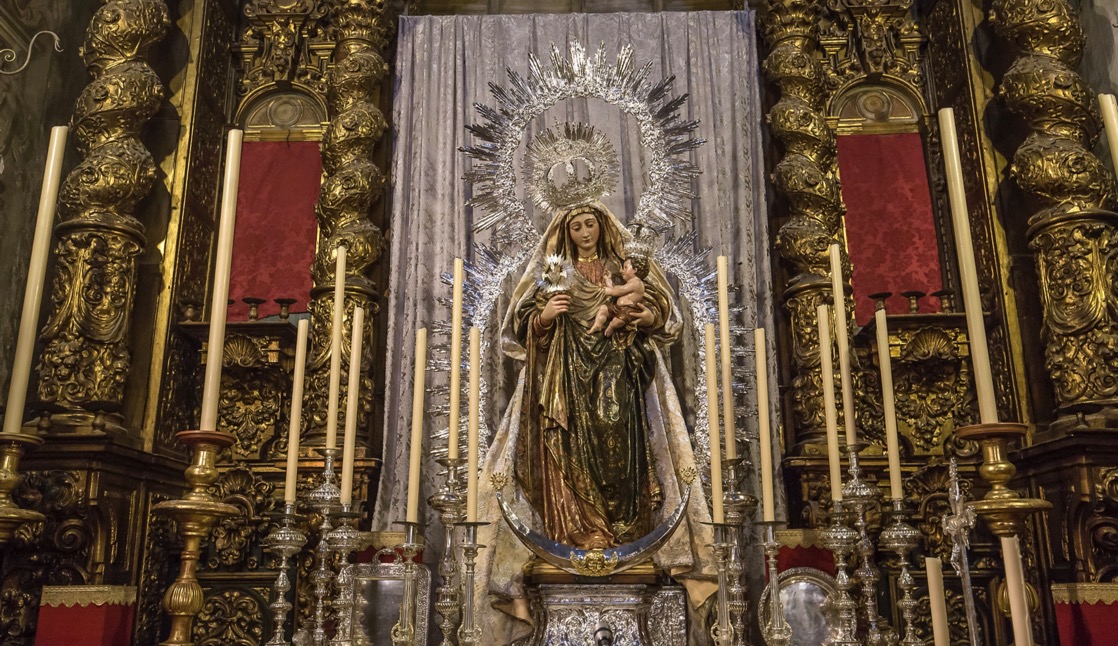
The Sacred Image is placed in an 18th century altarpiece (above) that originally sheltered the Christ of Confalón. The ensemble has undergone a €50,000 cleaning and restoration in 2021.
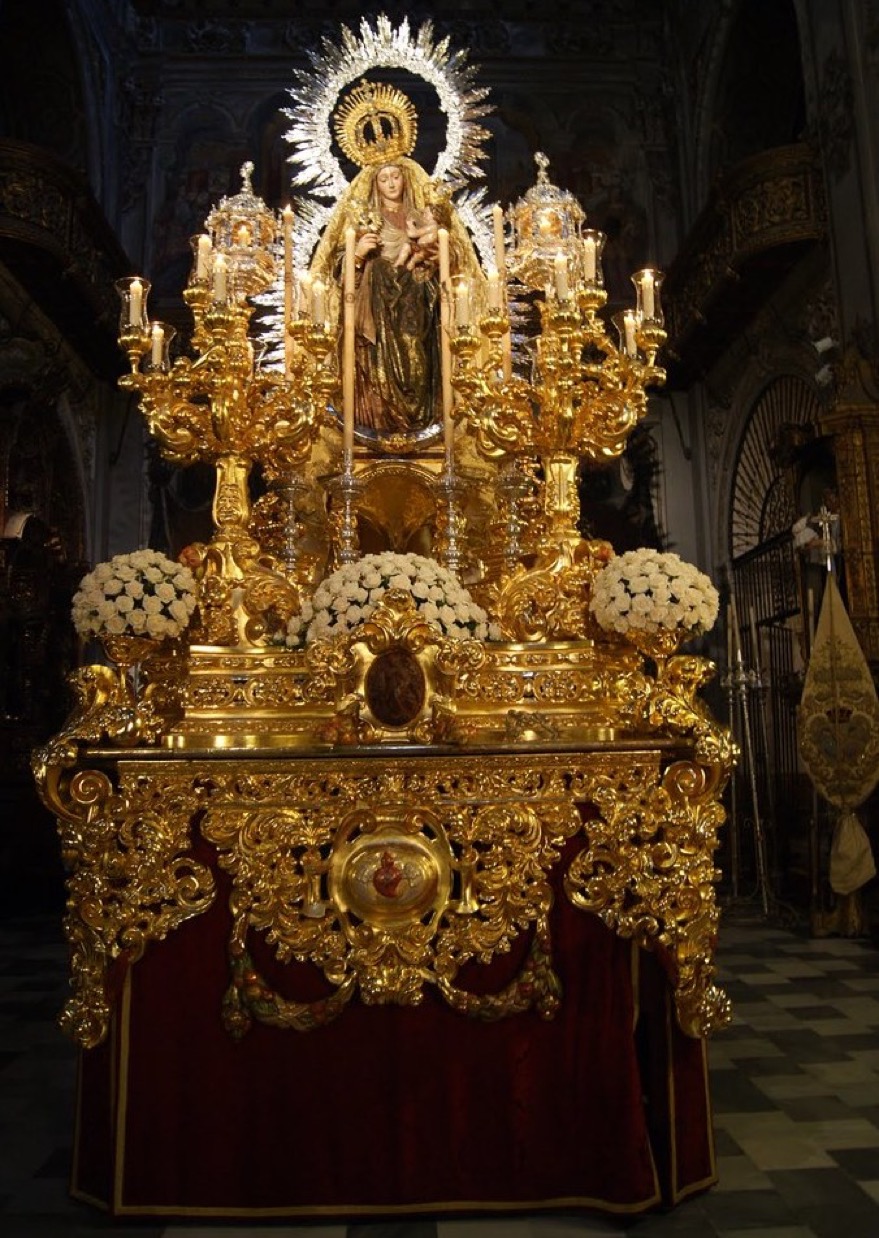
El Paso de Nuestra Señora del Amparo (above) was premiered in 1927, and is an extraordinarily sturdy structure, especially the chandeliers. In the neoclassical style, it consists of a mass of scrolls, ribbons, festoons, cornucopias, shells, moldings ... in solidly carved wood. The aim was to create a support that would not tremble or oscillate, but allow the fringes of the Virgin's mantle to sway. Her crown is gilded silver from the 17th century, and she often wears a cream-coloured mantle embroidered in gold from the first half of the 19th century.
The origin of the Hermandad del Calvario would appear to be based upon the much older Hermandad de la Presentación de Nuestra Señora (Brotherhood of the Presentation of Our Lady), which was specifically focussed on mulattoes, i.e. those of mixed white and black heritage. Because of Seville's role as a gateway to the Americas, the city had more than its fair share of mulattoes, both free and slaves, and both groups were racial, social and economic marginalised. When traffic from the Americas was transferred to Cádiz the Sevillian population suffered, as did the Brotherhoods, and in particular, one dedicated to mulattoes.
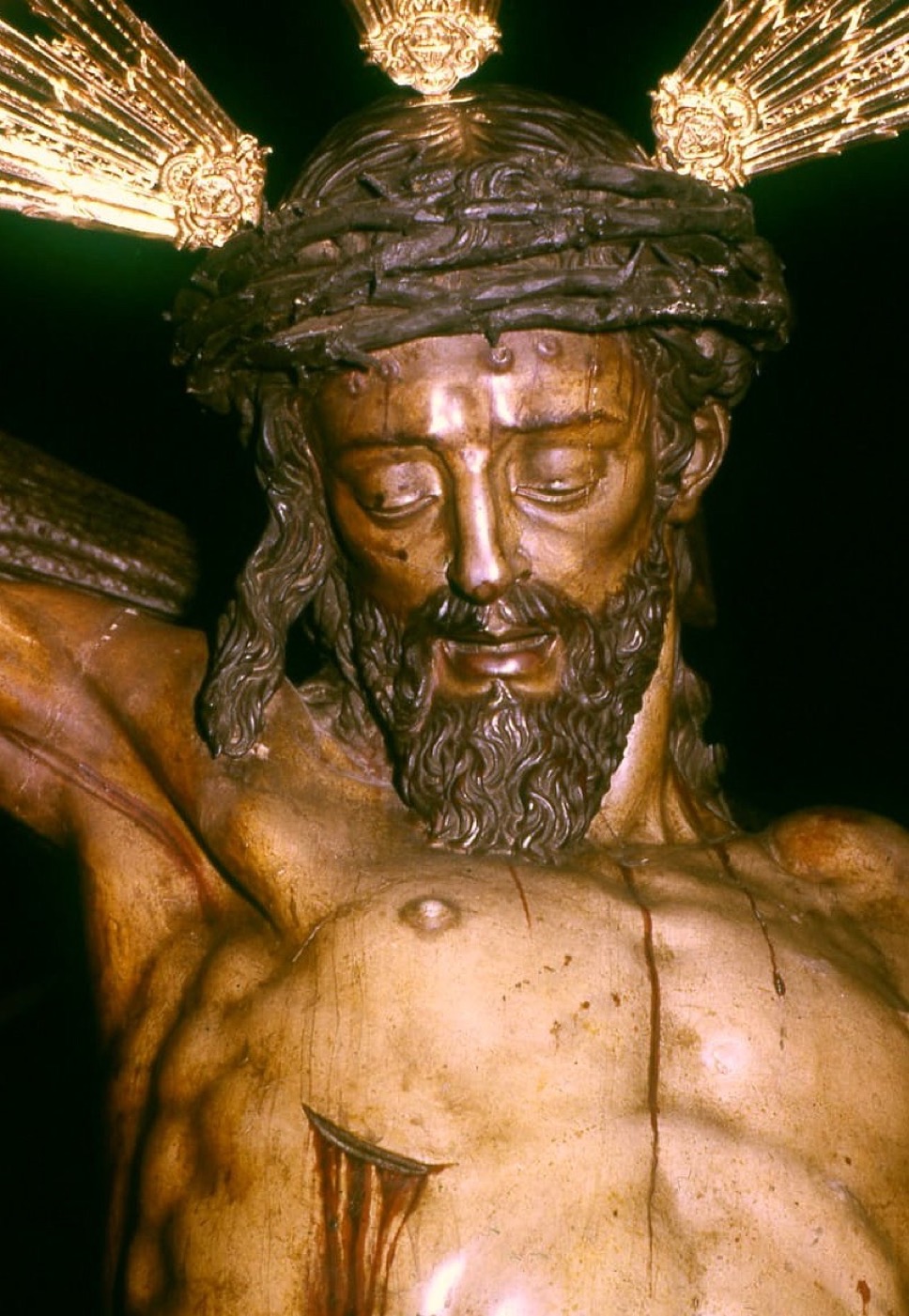
Today the brotherhood venerates two Sacred Images, the first is the Santisimo Cristo del Calvario (Christ of Calvary), and the second is Nuestra Señora de la Presentación. The first is a Mannerist-style carving of Christ on the Cross, produced between 1611 and 1612 by Francisco de Ocampo y Felguera (1579-1639). Originally attributed to a different craftsman, but during restoration a handwritten document by the artist was found inside the wooden sculpture. It was found along with a relic of the lignum crucis (a piece of the original cross), that since then has been in a reliquary often found at the foot of the Virgin. The deed dated November 5, 1611 was for a commission from Gaspar Pérez Torquemada to Francisco de Ocampo. He wanted a crucifix based upon the one dating from 1603 and know as the Cristo de la Clemencia, today located in the Cathedral. It was to be somewhat smaller than the original, as it was not designed to be part of a procession. According to the experts, Francisco de Ocampo produced a crucifixion of greater formal realism whilst retaining the pathos associated with the moment. It was in the last third of the 17th century, when the image passed into the possession of the old brotherhood of the mulattoes (antecedent to the current Hermandad del Calvario). From that moment it began to be carried in religions processions.

The Paso is equally impressive, even if only dating from 1909. There is a rock-shaped mountain, on which the cross of Christ of Calvary is placed. The frame is covered with silver cartouches with scenes of the Passion and busts of the apostles.

Nuestra Señora de la Presentación is attributed to the sculptor Juan de Astorga (1777-1849), and likely to date from sometime between 1834 and 1839. The attribution is based upon stylistic considerations, i.e. a great academicism in achieving a symbiosis between the ideal of romantic beauty and an idealised representation of pain.


The Paso dates from 1916, and includes velvets and embroidery from 1954, 1961, 1990 and 1992. Some decorative items were made in 1930 by a local goldsmith.
The full and official name is "Pontificia y Real Hermandad, y Archicofradía de Nazarenos del Dulce Nombre de Jesús, Sagrado Descendimiento de Nuestro Señor Jesucristo y Quinta Angustia de María Santísima Nuestra Señora", which fortunately has been often shortened to Hermandad de la Quinta Angustia. However, the reality is that this brotherhood worships three different Sacred Images, namely the Virgen de la Quinta Angustia, the Dulce Nombre de Jesús, and Cristo del Descendimiento.
My best translations would be the Sweet Name of Jesus, Sacred Descent of Our Lord Jesus Christ (descent from the Cross), and (I suppose) the Virgin of the Fifth Sorrowful Mystery. I've identified this last Sacred Image from the Sorrowful Mysteries, where the first is the Agony in the Garden, the second the Scourging at the Pillar, the third the Crowing with Thorns, the fourth the Carrying of the Cross, and the fifth and last is the Crucifixion and Death of our Lord.
Tradition has it that in 1500 a group of faithful began to meet to pray under the auspices of the Angustias de la Virgen al Pie de la Cruz (Anguish of the Virgin at the Foot of the Cross). Their first set of rules, dating from 1541, were for "Antigua Cofradía de Penitencia, Sangre y Luz del Sagrado Descendimiento de Nuestro Señor Jesucristo y Quinta Angustia de Nuestra Señora, sita en la Antigua Iglesia y Monasterio de Santa María del Carmen" (Old Brotherhood of Penance, Blood and Light of the Sacred Descent of Our Lord Jesus Christ and Fifth Anguish of Our Lady, located in the Old Church and Monastery of Santa María del Carmen). The Hermandad del Dulce Nombre de Jesús (Brotherhood of the Sweet Name of Jesus) was founded in 1572, and moved to its own chapel in 1576. The two brotherhoods joined together in 1851.
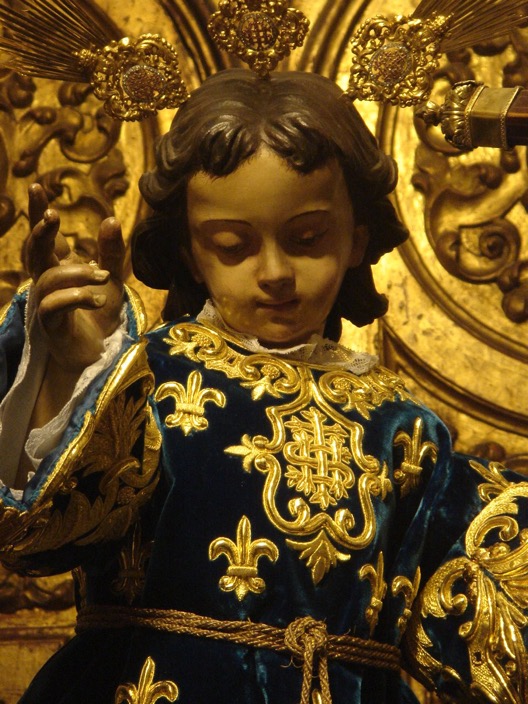
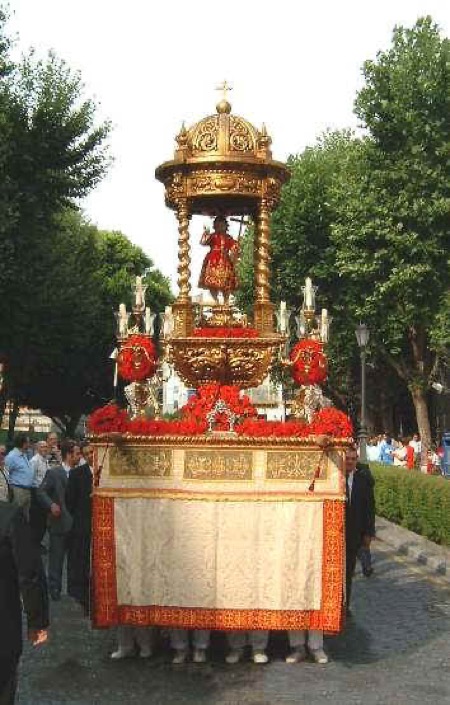
It was Jerónimo Hernández de la Estrada (1540-1586) who sculpted the 80 cm high polychrome image of Dulce Nombre de Jesús. Completed sometime between 1572 and 1582, it is thought to have been inspired by a baby Jesus painted for the Cathedral of Seville by Pedro de Villegas Marmolejo (1519-1596).
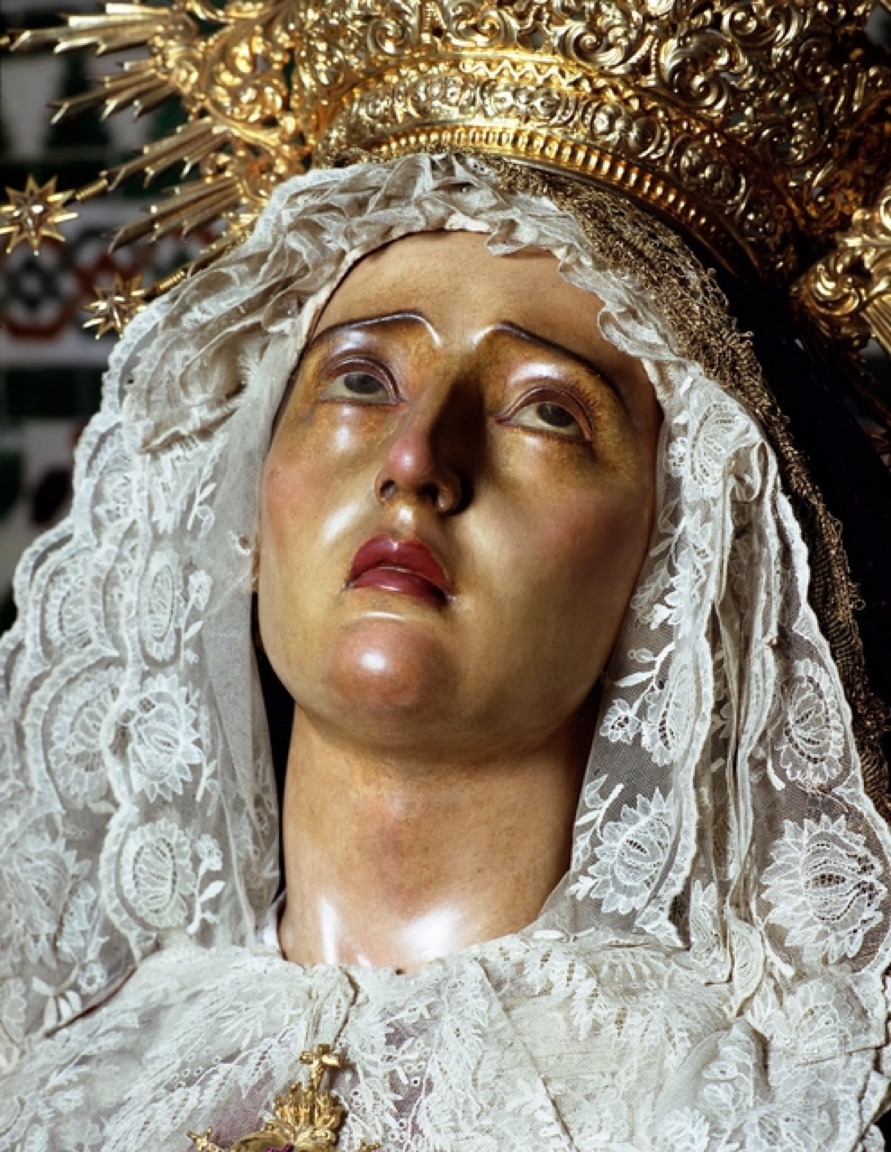
This impressive Sacred Image of María Santisima de la Quinta Angustia is a 178 cm tall polychrome wooden statue created by Vicente Rodríguez-Caso in 1934. It is considered one of the best Dolorosas (Sorrowful or Painful One) of the 20th century. The statue is said to have a mature face, representing the real age of the Virgin Mary during the Passion and Death of her son, Jesus. She is looking up, as her son is taken down from the Cross. Below we can see María Santisima de la Quinta Angustia alongside the Sagrado Descendimiento de Nuestro Señor Jesucristo.
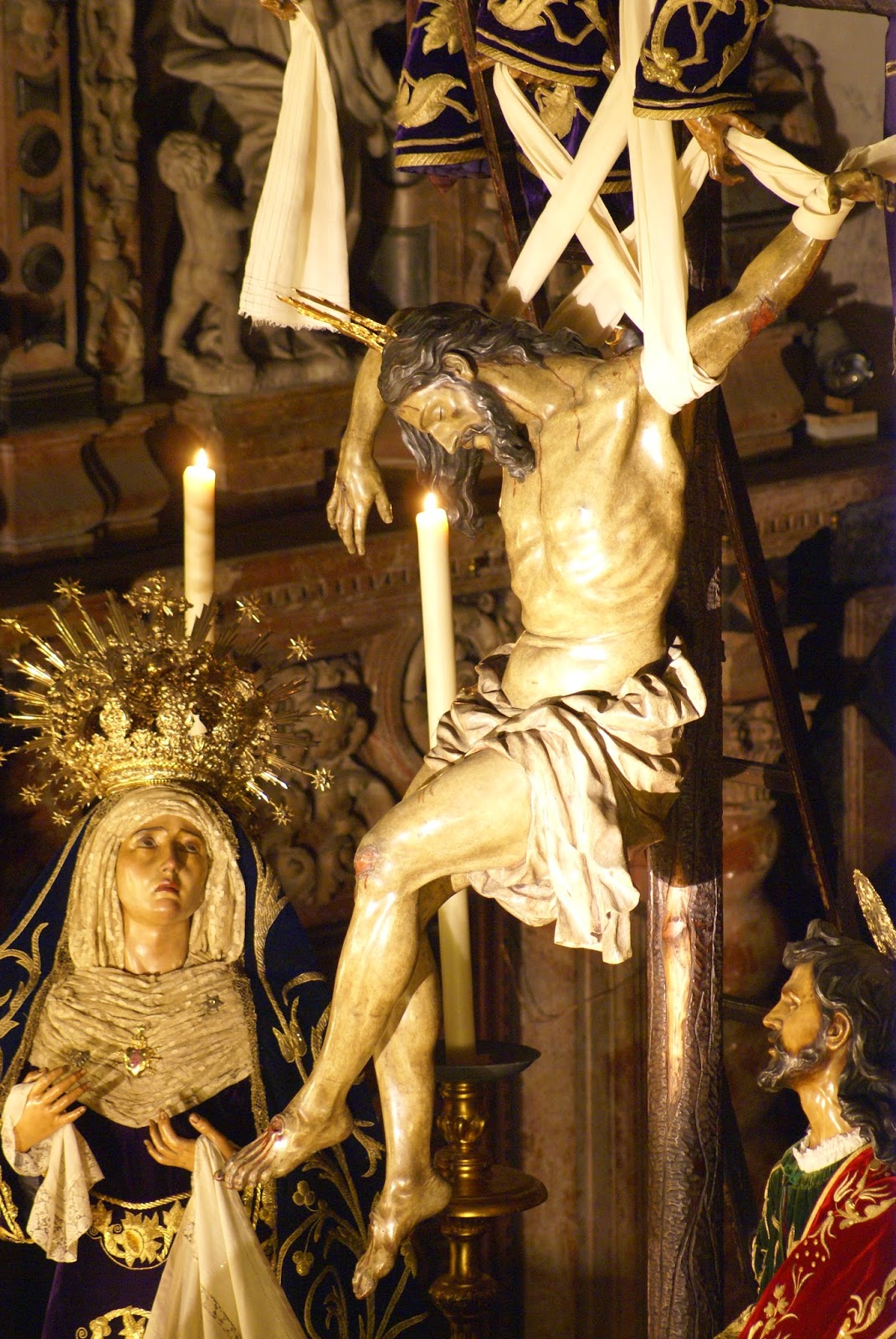
Certainly one of the most impressive pasos is the Sagrado Descendimiento de Nuestro Señor Jesucristo (Sacred Descent of Our Lord Jesus Christ) attributed to the sculptor Pedro Roldán, and dated to around 1659. The statue is only 164 cm high, but is considered to be of exceptional artistic quality and impact. The position of the limbs is the same as that of the Cristo del Descendimiento (Christ of the Descent) by Pedro de Campaña, a painting on panel dated to 1548 and currently preserved in the main sacristy of the Cathedral of Seville. Who polychromed the image is unknown, but they must have had a deep knowledge of the scientific study of the human body due to the way rigor mortis would have started to appear in the legs as a result of having died in an upright position.
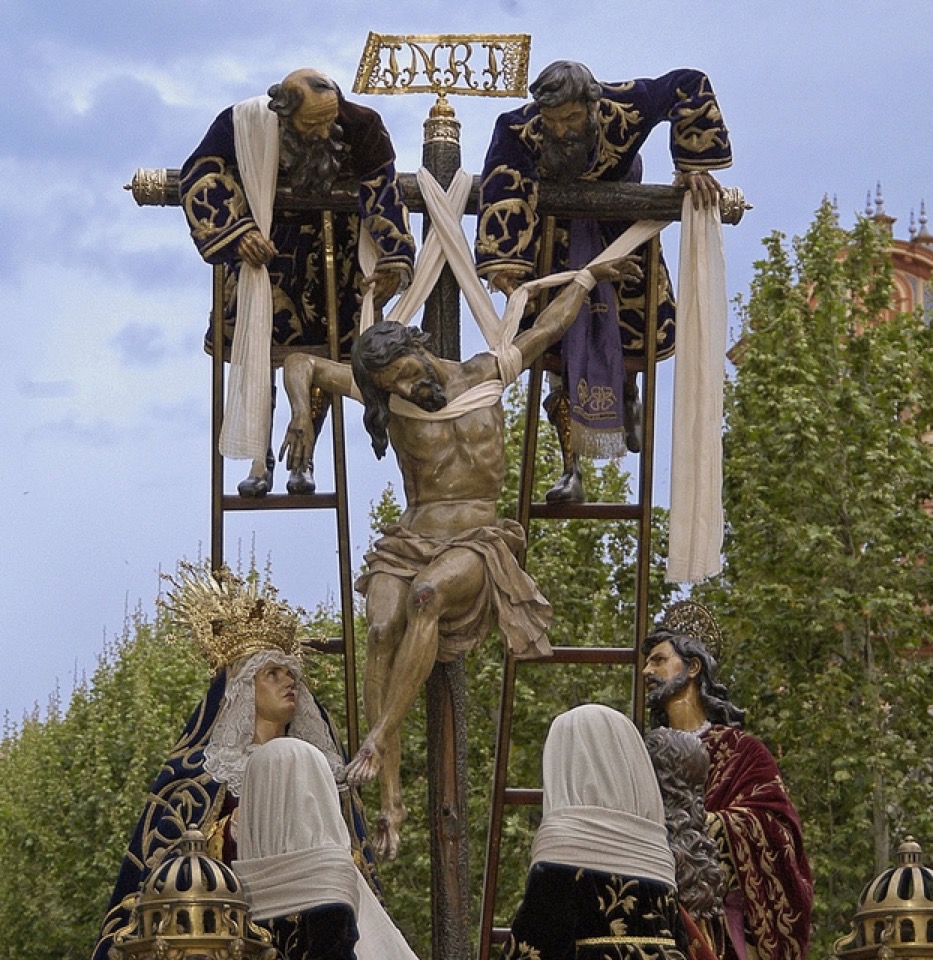
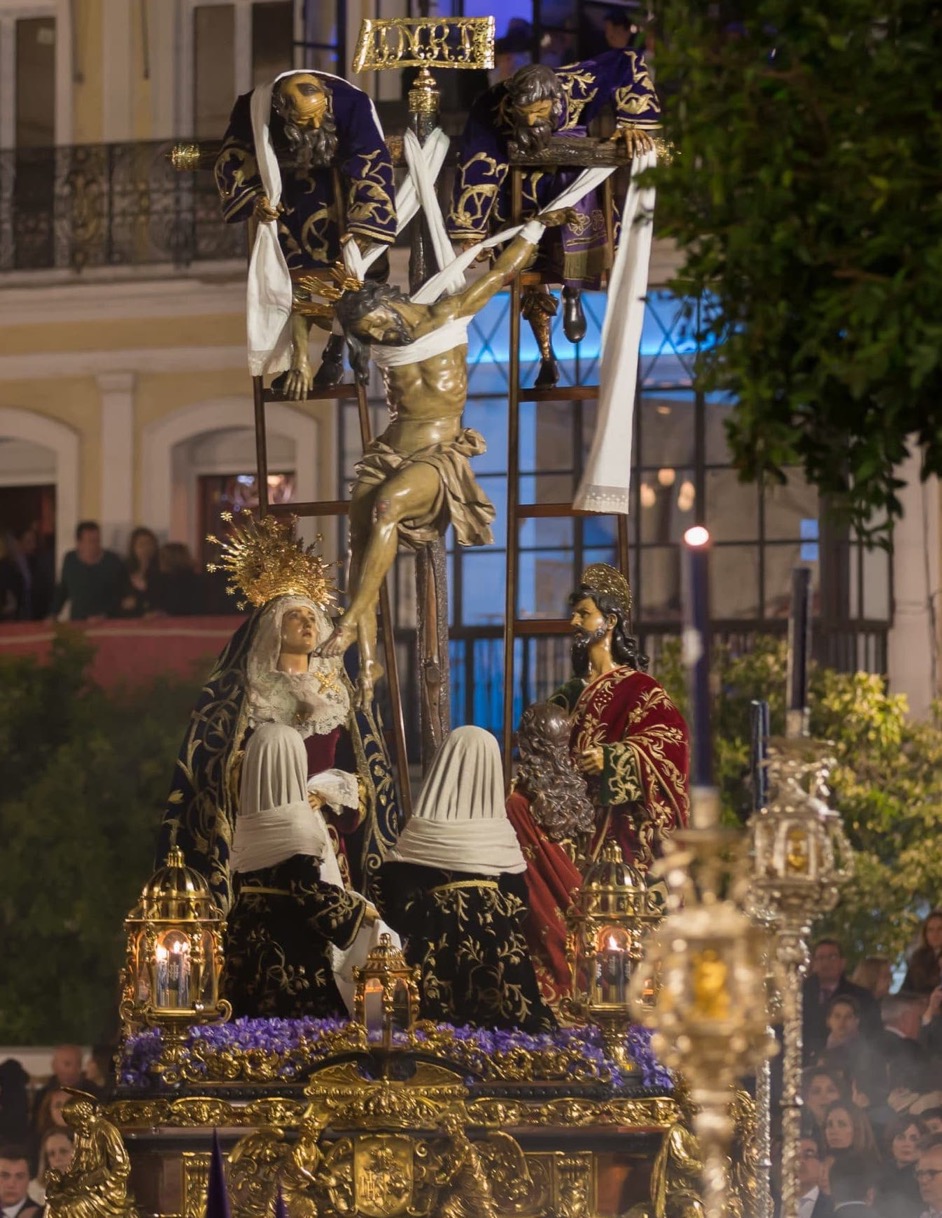
The Hermandad de Montserrat has it origins with Catalans who installed themselves in Seville in beginning of the 16th century. Later they were granted a plot of land to build a new chapel, which was completed in 1656. The Brotherhood reached its peak in the middle of the 17th century, when they moving to the convent of San Pablo. Canvas merchants initially supported the expenses of the Brotherhood. However it was the guild of canvas merchants itself that caused the decline of the Brotherhood, and by 1761 the guild had taken over the ownership of the chapel. In the Holy Week of 1849, several young devotees, considering that the Brotherhood was not extinct, proposed its reestablishment. The years that follow the reorganisation (1850-1868) were characterised by a Brotherhood which developed a romantic image of themselves and built a heritage that still persists today. It is said that it is now one of the largest brotherhoods in Seville. In 1939 the Brotherhood moved to the current chapel, which was still within the limits of the old convent. The chapel is actually just across the road from the church.
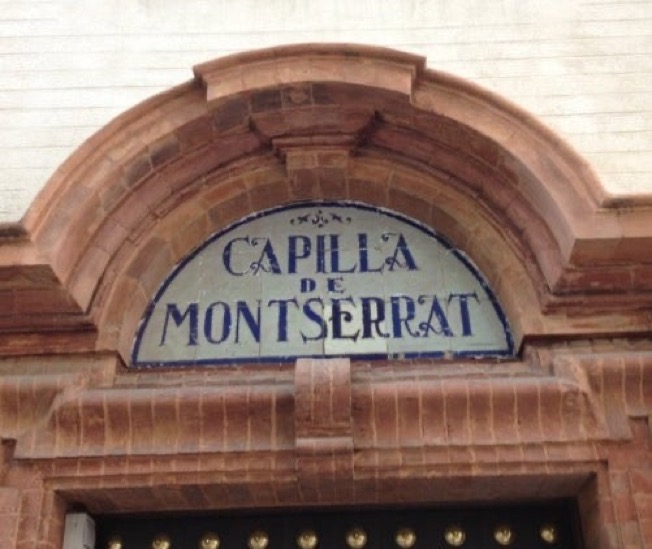
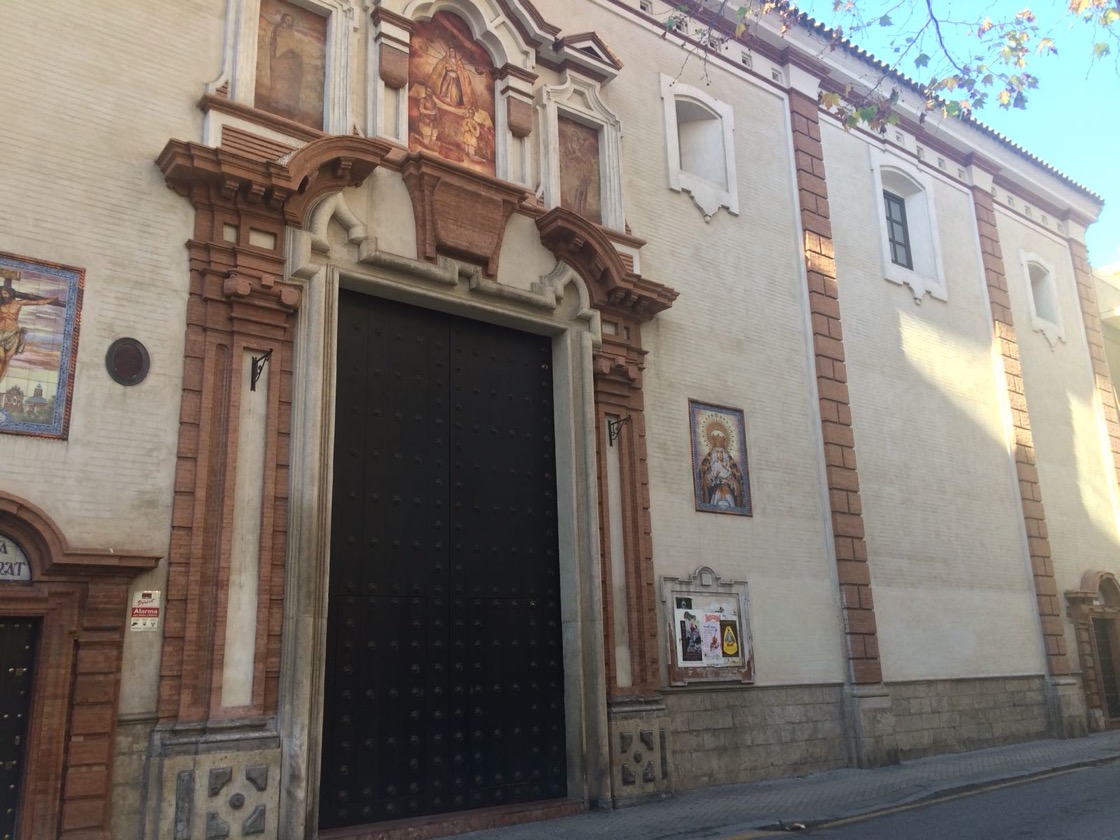
The Chapel of Montserrat was built next to the convent of San Pablo at the beginning of the 18th century, by Leonardo de Figueroa (ca. 1650-1730). The chapel had been built for the Brotherhood of Nuestra Señora de la Antigua and Siete Dolores (Hermandad de Nuestra Señora de la Antigua y Siete Dolores), which no longer exists.
The Chapel of Montserrat has been occupied by the Brotherhood of Montserrat since 1939, when its previous chapel was demolished. In 1939 it became the seat of "la Hermandad de Nuestra Señora del Rosario y Cofradía de Nazarenos del Santísimo Cristo de la Conversión del Buen Ladrón y Nuestra Señora de Montserrat" (roughly translated as Brotherhood of Our Lady of the Rosary and Brotherhood of Nazarenes of the Holy Christ of the Conversion of the Good Thief and Our Lady of Montserrat). This was a devotional cult brought by Catalans installed in Seville for trade with America. Since 1611 the brotherhood has been attached to the Monastery of Our Lady of Montserrat in Catalonia (Monasterio de Nuestra Señora de Montserrat en Cataluña).

The first Sacred Image is El Santísimo Cristo de la Conversión del Buen Ladrón (The Holy Christ of the Conversion of the Good Thief). Which is a carving of the crucified Christ by the sculptor Juan de Mesa, executed between 1619 and 1620. Made of polychrome decorated wood, 1.92 meters high, it represents Christ crucified alive. He is in an attitude of dialogue, at the moment in which he speaks with Saint Dimas, the Penitent Thief, who is at his side.
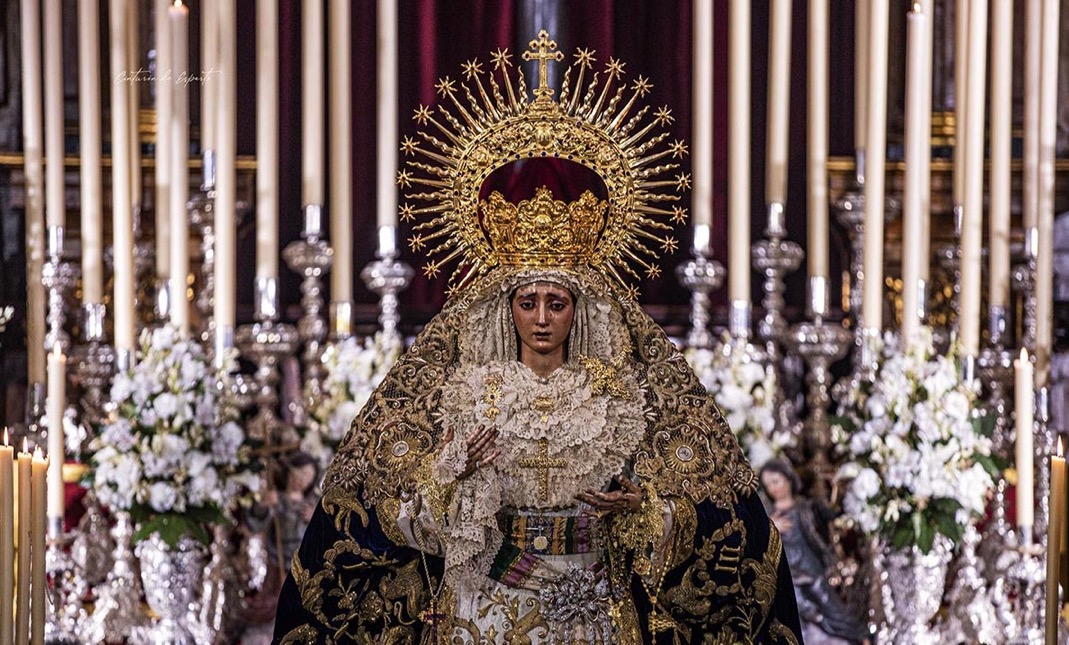
The second Scared Image is Nuestra Señora de Montserrat (Our Lady of Montserrat), who is a Dolorosa (Sorrowful Woman) by an unknown artist. It is an image of great beauty, with a questioning expression, and anguish in her eyes.
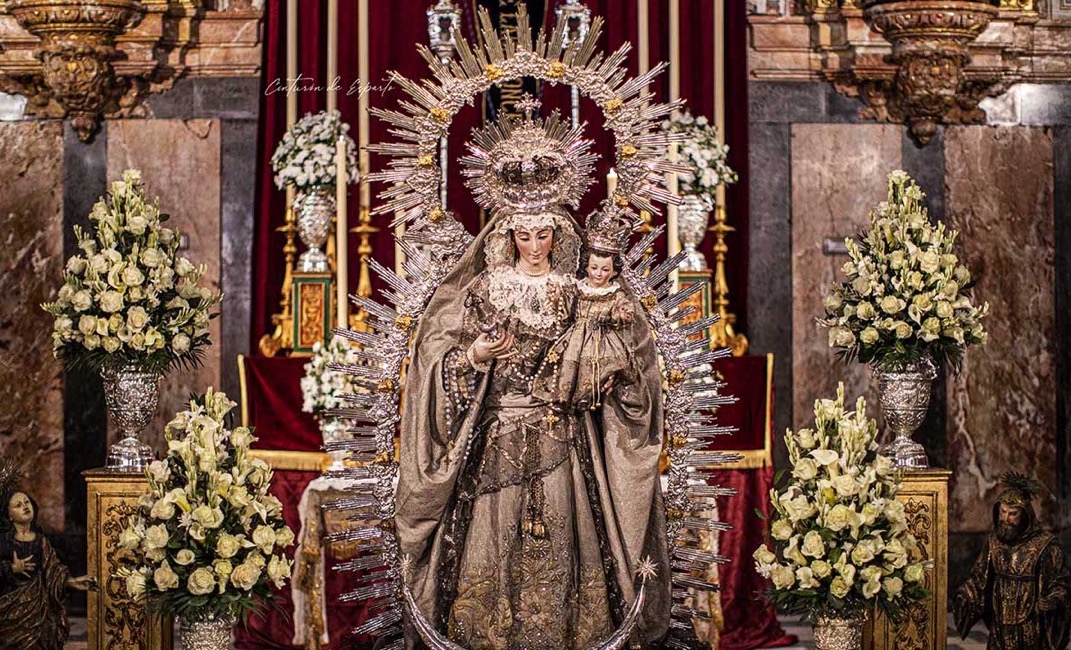
The third Sacred Image is Nuestra Señora del Rosario (Our Lady of the Rosary), a carving of Cristóbal Ramos (1725-1799) dated 1787. It originally belonged to the Brotherhood of the Rosary of the Convent of San Pablo (Real Hermandad del Rosario del Convento de San Pablo el Real), before they merged with Hermandad de Montserrat in 2006.
There was once an early brotherhood dedicated to the Nuestra Señora del Rosario (Our Lady of the Rosary). It is thought to have emerged as early as 1479, but complete documentation only exists from the end of the 16th century. Initially the brotherhood included many belonging to the nobility of the city, however, the brotherhood became more open to other social classes after the plague of 1649. Among the 582 brothers registered in the 17th century, Bartolomé Esteban Murillo (1617-1682) stands out as a life-long member. In the 19th century, the brotherhood suffered a profound decline as a result of the confiscation of the assets of the Convent of San Pablo. In 1867 the brotherhood merged with the brotherhood of penance of the Holy Christ of the Conversion of the Good Thief and Our Lady of Montserrat.
The Roof of Iglesia de la Magdalena
Although everyone enters and leaves the church by the side door in C/San Pablo, the main entrance is in fact in the narrower C/Cristo del Calvario. And it is about this façade that we find the bells of the church.

I could not find any information on this set of bells, despite the Valencian bell ringers listing an impressive list of bells in Seville (but not mentioning those in this church).
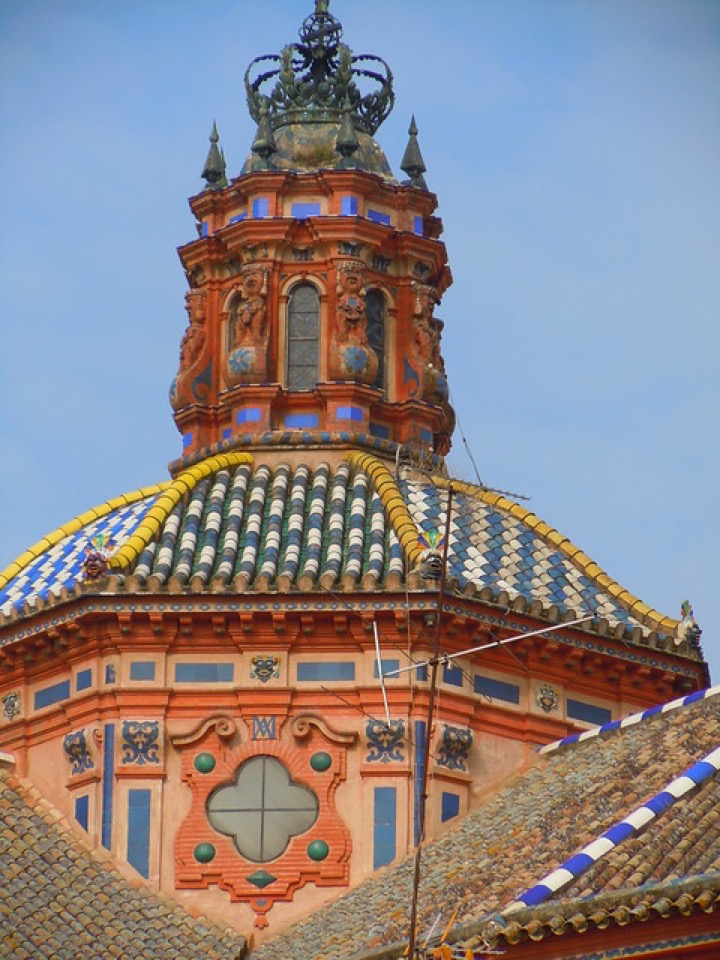
Disappointed, I turned to the central dome on the roof. The wooden dome was the work of master Leonardo de Figueroa and dates from between 1690 and 1709. Experts have noted that the dome, together with the excessive belfry, assumed a role consistent with the importance of the Dominican order in the city. In some ways they were competing with old minarets and bell towers.
Figueroa actually built several dome-on-drum roofs, and the idea was applied to both renovations and new builds scattered throughout the archbishop of Seville. When the renovation work of the church collapsed in 1691, the architect became almost obsessive in applying reinforcements and safety elements. He ingeniously reused the wall structures and pilasters that were still standing, significantly modifying the spatial character of the temple, reinforcing everything to receive the new distribution of barrel vaults with lunettes, and a dome on pendentives in the nave.
Experts have suggested that Figueroa wanted to keep costs down by using the existing remains, introducing moderate charges and avoiding the extensive use of stone. For this he could count on models and techniques already experienced and typified by Fray Lorenzo de San Nicolás (1593-1679) in his Arte y Uso del la Arquitectura published just thirty years earlier (in 1664). For example, he suggested to "try to cover large or small chapels with wood", based on its suitability when walls were not thick and strong, or when stone would cost too much. Figueroa also appeared to believe that wood performed better than brick in the face of seismic movements. Secondly, using wood and brick masonry would be faster and cheaper. Thirdly, wood weighted less than brick or stone. Fourthly, stone was scarce and thus expensive. In addition, it was believed that it was necessary to allow ashlars (i.e. dressed stone) to mature for at least two years between extraction and commissioning (which was almost never done in reality). Finally, Figueroa felt that wood and brick was easier to repair, since panels or sections of brick was easier to replace as compared to stone. The debate about wood/brick or stone would continue for some considerable time.
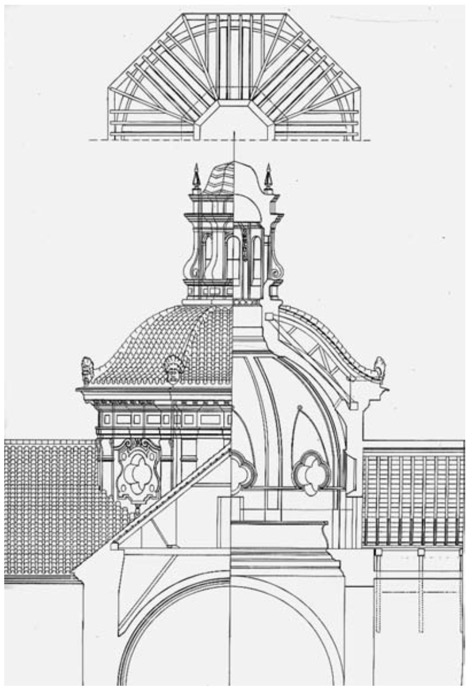
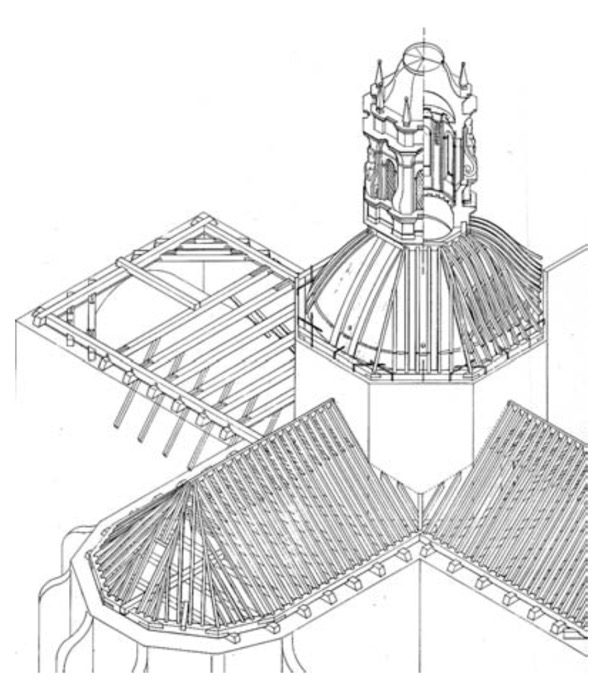
The design of Figueroa involved a dome sitting on the four large transverse arches that in turn sat on the walls of the pre-existing central nave and the new transept. Importantly the wooden structure that covered the vaults of the naves and presbytery were locked together when reaching the transept, considerably improving the overall stability of the drum and dome. When mentioning a wooden structure we have to remember that iron elements were embedded in the middle of the wooden beams to stabilise the octagonal shape, and the entire structure was anchored to walls using oversized iron bars.
The appearance of the drum and the elevation of the dome and its lantern became a new element of urban architecture. It was recognised that a central stone vault covered in slate or lead was not always watertight. Using a raised dome on a drum did not need the use of stone, and allowed the introduction of new elements, such as the introduction of interior or exterior galleries (or balcony). It also meant that ceramic tiles could be used. They were already used locally, and in addition had received an impulse from across the Atlantic (e.g. ceramic acroteras representing indigenous heads, etc.).

Christmas Nativity Scene
It is common practice for both churches and chapels to present a Belén, or Christmas nativity scene. Whilst much effort is spent on them, they often all look the same. I would like to offer just three photographs of the Belén made by the Hermandad de la Quinta Angustia in the Chapel of Dulce Nombre de Jesús. Enjoy…


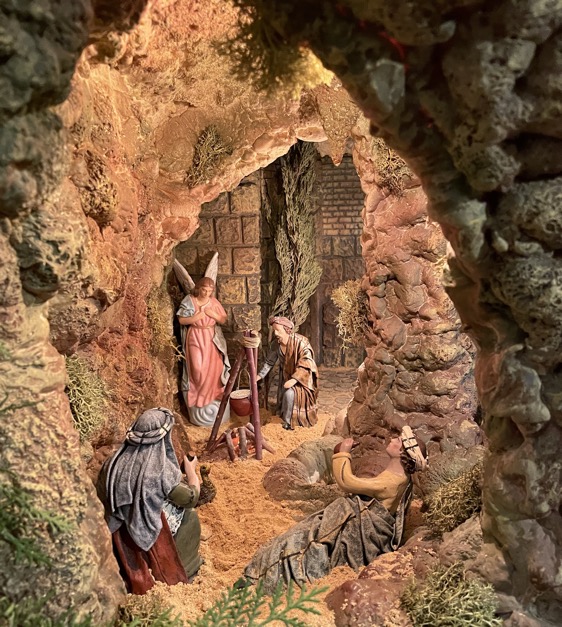
References
Leyendas de Sevilla has a great set of webpages on:-
Iglesia de Santa María Magdalena-I (July 2011)
Iglesia de Santa María Magdalena y II (July 2011)
Capilla de Monstserrat (July 2011)
Iglesia de Santa María Magdalena, -I. Historia y exterior (October 2015)
Iglesia de Santa María Magdalena, -II. Capilla del Dulce Nombre de Jesús (October 2015)
Iglesia de Santa María Magdalena, -III. Nave de la Epístola y presbiterio (November 2015)
Iglesia de Santa María Magdalena, IV - Nave central y presbiterio (November 2015)
Iglesia de Santa María Magdalena, -V y final. Nave del Evangelio (November 2015)
Real Parroquia Santa María Magdalena, Sevilla (including a 360° visit and a YouTube channel)
Iglesias de Sevilla: La Magdalena I and Iglesias de Sevilla: La Magdalena I
Iglesia de Santa María Magdalena
La Magdalena (a flickr collection)
La Desaparecida Capilla de Montserrat
Hermandad del Calvario
Hermandad de Nuestra Señora del Amparo
Hermandad de la Quinta Angustia
Hermandad de Montserrat
Salvador Rubiales Márquez, et.al., "Plan Especial de Protección del Convento de San Pablo (Sevilla)" (1970)
Francisco Pinto Puerto, "El cimborrio de madera del antiguo convento de San Pablo de Sevilla" (2005)
Restauración de la linterna de la Iglesia de la Magdalena en Sevilla (2015)
José Roda Peña, "Nuevas noticias sobre la ruina y reconstrucción de la iglesia del Real Convento de San Pablo de Sevilla, según un manuscrito inédito de 1692-1708" (2016)
Rafael Guirado Romero "La Cofradía del Dulce Nombre de Jesús de Sevilla (1572-1629)" (2020)